A remarkable transformation occurs in Wisconsin’s frigid winter months when the landscape is blanketed in snow and temperatures plummet.
This season brings with it the arrival of numerous resilient and hardy bird species, each uniquely adapted to survive the challenges of the cold.
From the Northern Cardinal’s enchanting iridescence to the Snowy Owl’s stoic presence, Wisconsin’s winter bird population is a testament to nature’s ability to thrive in adversity.
In exploring “47 Winter Birds in Wisconsin,” we will embark on a journey through the state’s winter wonderland.
We will unveil the stories of these feathered inhabitants, shedding light on their behaviors, migrations, and survival strategies in the face of freezing conditions.
Join us as we celebrate Wisconsin’s winter birds’ enduring beauty and vitality, making this season a time of discovery, wonder, and admiration for the avian wonders that call the state home during the colder months.
47 Winter Birds In Wisconsin
Winter in Wisconsin brings a variety of bird species that are adapted to cold temperatures and are often seen at bird feeders and in natural habitats.
Here’s a list of 47 winter birds you might encounter in Wisconsin:
1. Black-Capped Chickadee (Poecile atricapillus)
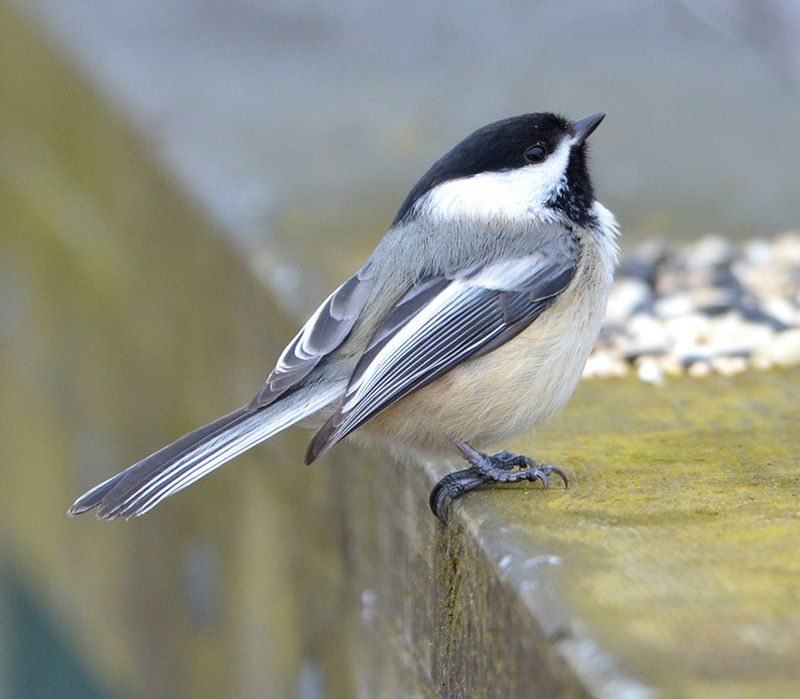
The Black-Capped Chickadee is a small, charismatic bird found throughout North America. Recognizable by its distinctive black cap and bib, it is known for its cheerful “chick-a-dee-dee-dee” call.
These social birds are highly adaptable, thriving in various habitats, including forests, woodlands, and even suburban areas.
They primarily feed on insects and seeds, often hiding food in bark crevices for later consumption. Black-Capped Chickadees are cavity nesters and may use abandoned tree holes or birdhouses.
Their ability to withstand harsh winters by lowering their body temperature at night is an impressive survival strategy.
| Kingdom | Animalia |
| Phylum | Chordata |
| Clade | Dinosauria |
| Class | Aves |
| Order | Passeriformes |
| Family | Paridae |
| Genus | Poecile |
| Species | P. atricapillus |
2. House Sparrow (Passer domesticus)
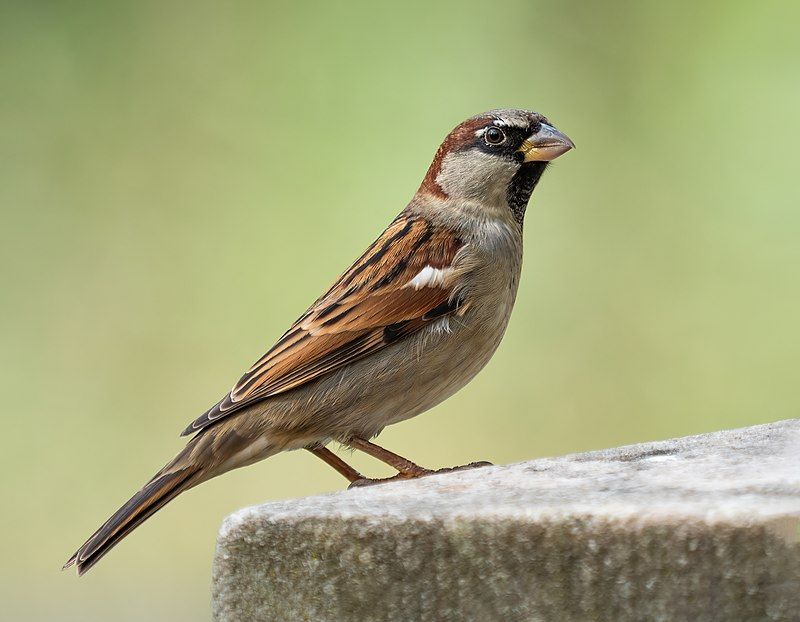
The House Sparrow, an introduced species in North America, is a small, brownish bird with a distinctively stubby bill and grayish crown.
Highly adaptable, they are often found near human habitation, foraging for food scraps, and nesting in buildings.
Males display a black bib during the breeding season. House Sparrows are social birds and can be both charming and pesky. Their global distribution has made them one of the world’s most widely distributed bird species.
| Kingdom | Animalia |
| Phylum | Chordata |
| Clade | Dinosauria |
| Class | Aves |
| Order | Passeriformes |
| Family | Passeridae |
| Genus | Passer |
| Species | P. domesticus |
3. Northern Cardinal (Cardinalis cardinalis)
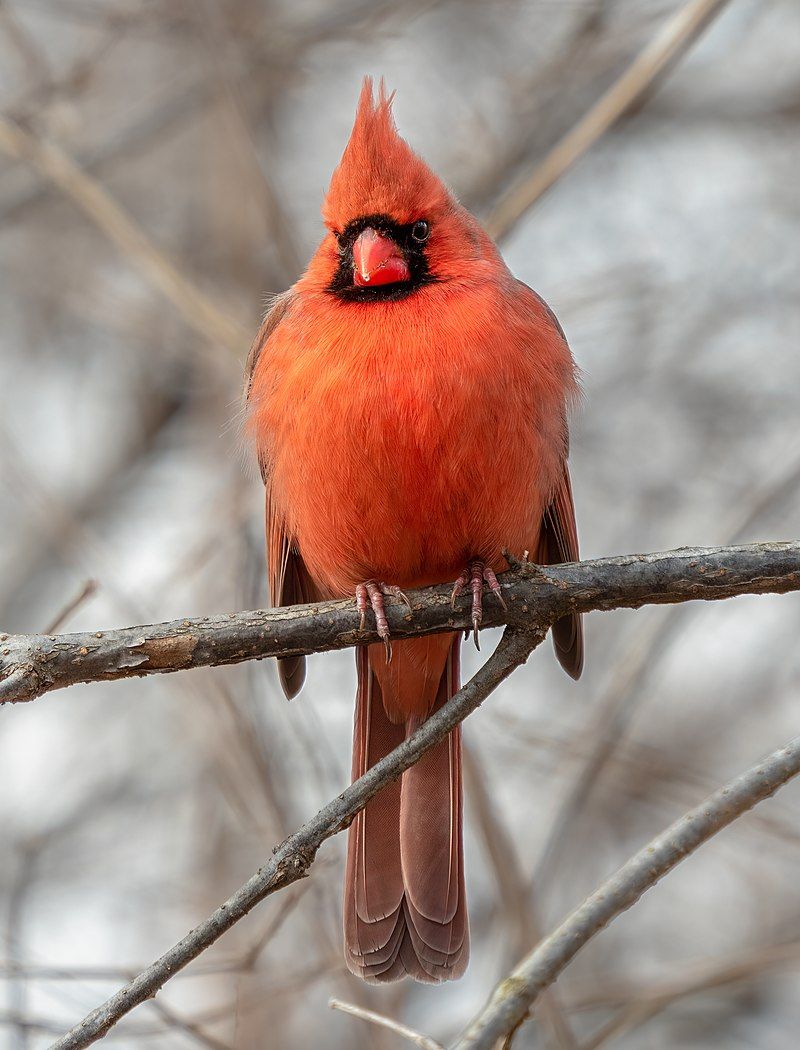
The Northern Cardinal, with its vibrant red plumage and distinctive crest, is one of the most iconic birds in North America. These songbirds are known for their melodious, whistling calls and are often seen perched in gardens and woodlands.
Cardinals are year-round residents, adding a splash of color to winter landscapes. Males are brilliantly red, while females are more subdued with brownish-red plumage.
These birds are primarily seed-eaters and frequent bird feeders, making them a favorite among birdwatchers.
| Kingdom | Animalia |
| Phylum | Chordata |
| Clade | Dinosauria |
| Class | Aves |
| Order | Passeriformes |
| Family | Cardinalidae |
| Genus | Cardinalis |
| Species | C. cardinalis |
4. American Goldfinch (Spinus tristis)
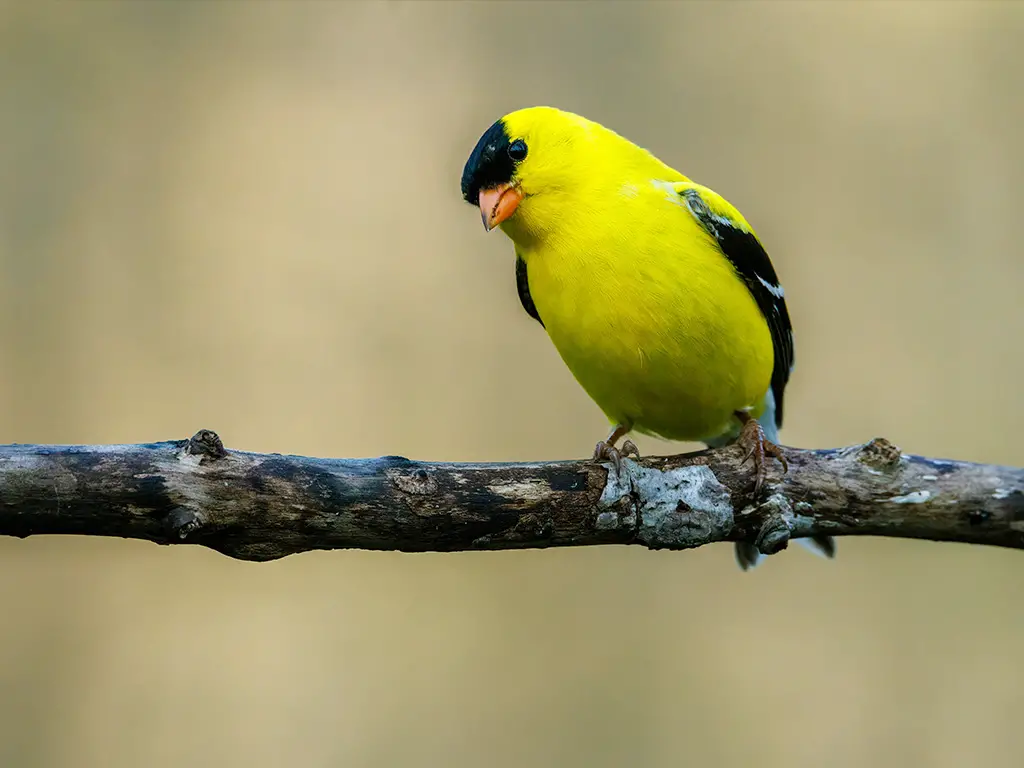
The American Goldfinch, also known as the Eastern Goldfinch or Wild Canary, is a small, bright yellow bird found across North America.
Their plumage changes dramatically throughout the year, with the males donning their brightest yellow feathers during the breeding season.
Goldfinches are seed-eaters and are often seen perched on thistle plants or visiting bird feeders stocked with sunflower seeds. They are highly gregarious and form small flocks, especially during the non-breeding season.
| Kingdom | Animalia |
| Phylum | Chordata |
| Clade | Dinosauria |
| Class | Aves |
| Order | Passeriformes |
| Family | Fringillidae |
| Genus | Spinus |
| Species | S. tristis |
5. Downy Woodpecker (Picoides pubescens)
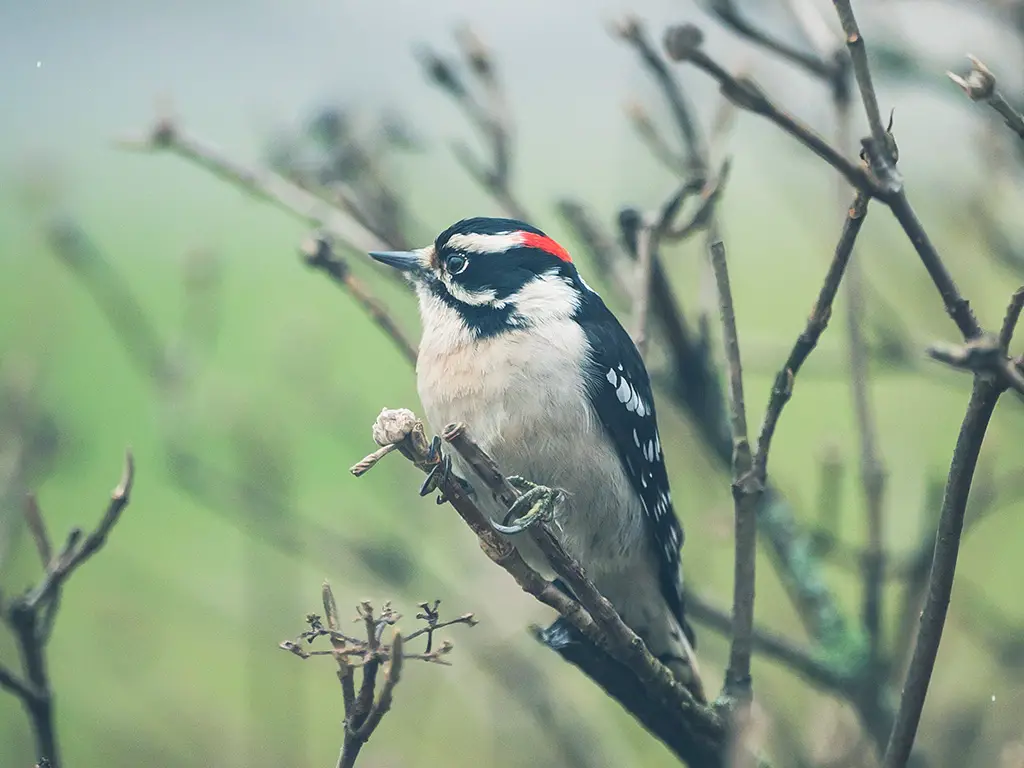
The Downy Woodpecker is North America’s smallest and most widespread woodpecker species. These charming birds are easily identified by their black-and-white plumage, small size, and the presence of a white stripe down their wings.
Downy Woodpeckers are often seen foraging on tree trunks and branches, using their sturdy bills to probe for insects and larvae.
They are known for their distinctive drumming sounds and calls. These woodpeckers are cavity nesters, often utilizing old tree holes or man-made nest boxes for raising their young.
| Kingdom | Animalia |
| Phylum | Chordata |
| Clade | Dinosauria |
| Class | Aves |
| Order | Piciformes |
| Family | Picidae |
| Genus | Dryobates |
| Species | D. pubescens |
6. Cardinalidae
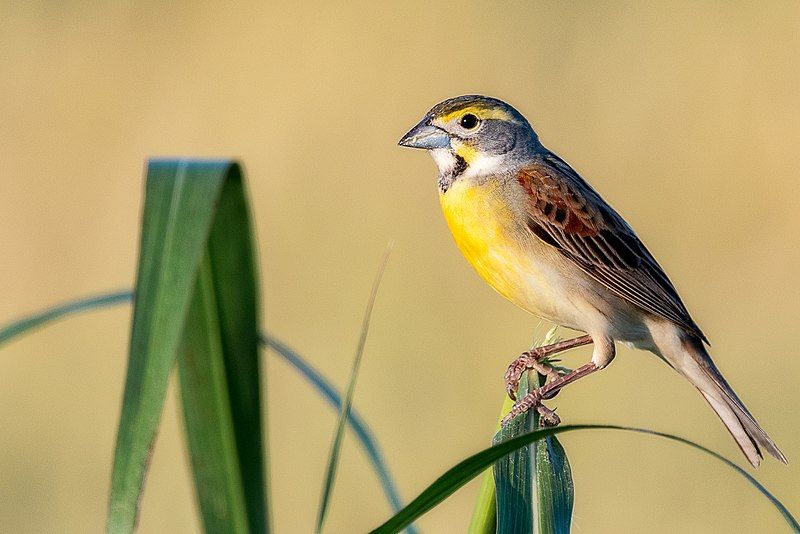
Cardinalidae is a diverse family of songbirds primarily found in the Americas. Notable members include the Northern Cardinal (Cardinalis cardinalis) and the Summer Tanager (Piranga rubra).
These birds are often characterized by their vibrant plumage, melodious songs, and strong beaks. Cardinals, like the Northern Cardinal, are famous for their stunning red plumage in males and more muted colors in females.
They are year-round residents in many areas and are a favorite among bird enthusiasts. Summer Tanagers are known for their bright red plumage and insectivorous diet. This family showcases various colors and behaviors, making it a fascinating group for birdwatchers.
| Kingdom | Animalia |
| Phylum | Chordata |
| Clade | Dinosauria |
| Class | Aves |
| Order | Passeriformes |
| Family | Cardinalidae |
7. Woodpeckers
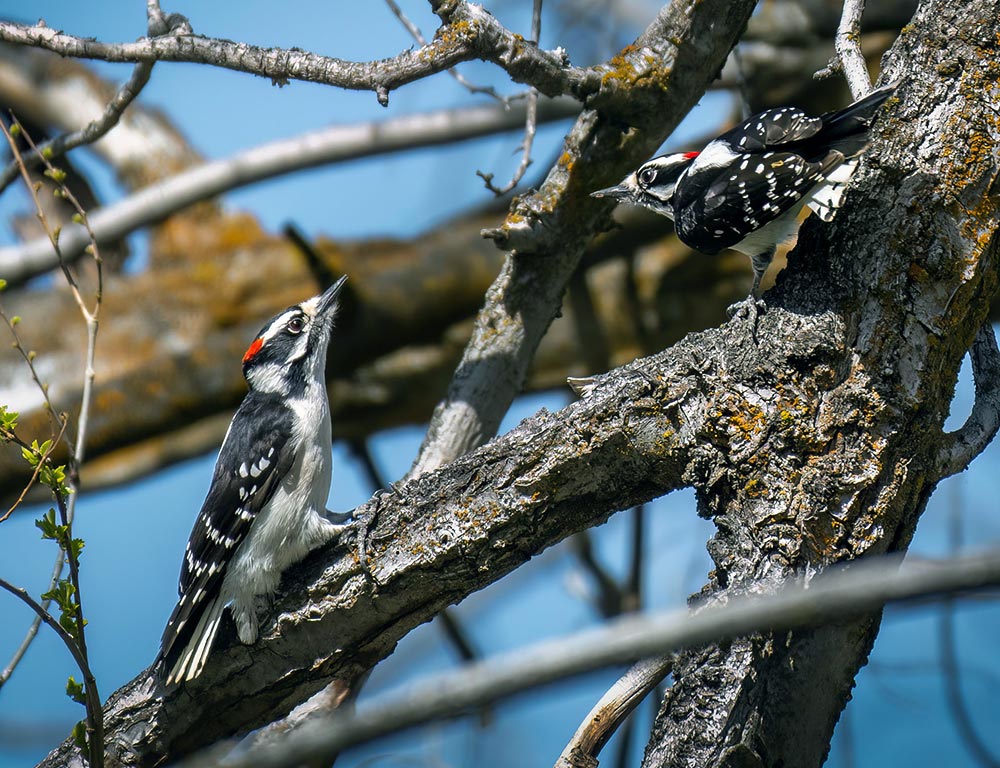
Woodpeckers are a diverse family of birds known for their specialized adaptations, including strong bills and a unique drumming behavior. The Downy Woodpecker (Picoides pubescens) is a common representative.
These small birds feature black-and-white plumage with a distinctive stripe down their wings. They use their bills to drum on tree trunks, which serve various purposes, including communication and foraging for insects.
Woodpeckers are expert foragers, using their long tongues to extract prey from tree crevices. Their presence is often associated with healthy forest ecosystems, as they help control insect populations and create nesting cavities for other birds.
| Kingdom | Animalia |
| Phylum | Chordata |
| Clade | Dinosauria |
| Class | Aves |
| Order | Piciformes |
| Family | Picidae |
8. Blue Jay (Cyanocitta cristata)
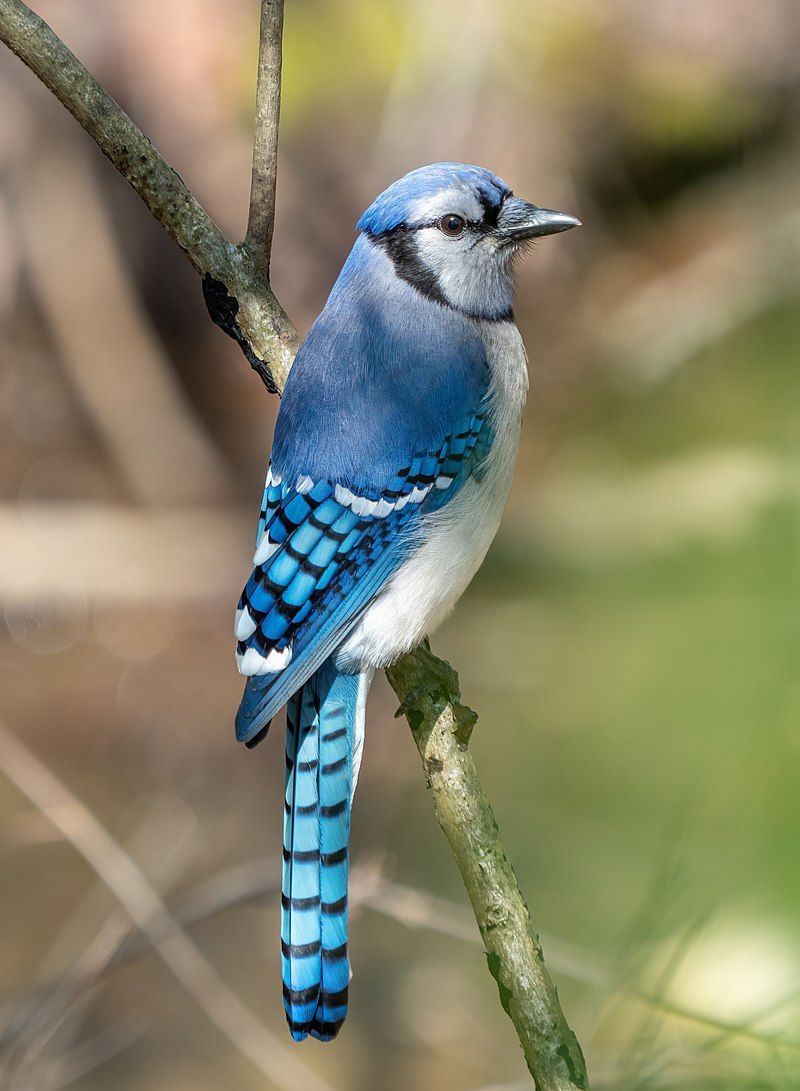
The Blue Jay is a striking bird native to North America, recognized by its brilliant blue plumage and white markings.
Known for their intelligence and raucous calls, they are often found in woodlands, suburban areas, and parks. Blue Jays are omnivorous, feeding on insects, seeds, fruits, and even small vertebrates.
They are also known for their habit of caching food and burying it in the ground for later consumption. These birds are highly vocal, with a range of calls, including their characteristic “jay-jay” cry. Blue Jays are active year-round and can be a delight to observe at bird feeders.
| Kingdom | Animalia |
| Phylum | Chordata |
| Clade | Dinosauria |
| Class | Aves |
| Order | Passeriformes |
| Family | Corvidae |
| Genus | Cyanocitta |
| Species | C. cristata |
9. Pine Siskin (Spinus pinus)
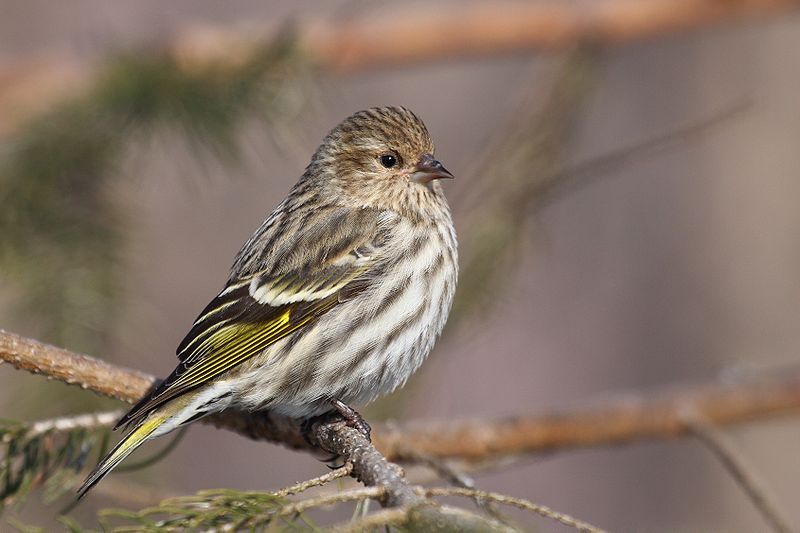
The Pine Siskin is a small finch species with a slender body and a distinctive streaked appearance. Found across North America, these birds often visit coniferous forests and feed on seeds from pine cones, giving them their name.
Pine Siskins are highly nomadic and irruptive, with populations fluctuating widely in response to food availability.
They are often seen in mixed flocks with other finches, particularly during winter. Their cheerful twittering calls and sociable behavior make them a welcomed sight for bird enthusiasts.
| Kingdom | Animalia |
| Phylum | Chordata |
| Clade | Dinosauria |
| Class | Aves |
| Order | Passeriformes |
| Family | Fringillidae |
| Genus | Spinus |
| Species | S. pinus |
10. American Tree Sparrow (Spizelloides arborea)
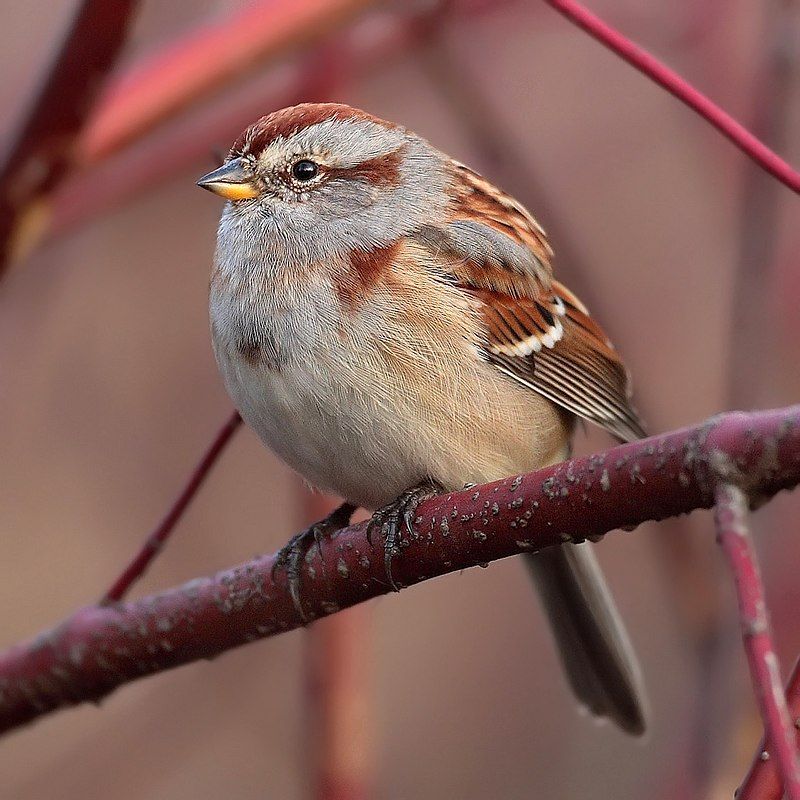
| Kingdom | Animalia |
| Phylum | Chordata |
| Clade | Dinosauria |
| Class | Aves |
| Order | Passeriformes |
| Family | Passerellidae |
| Genus | Spizelloides |
| Species | S. arborea |
11. Songbirds
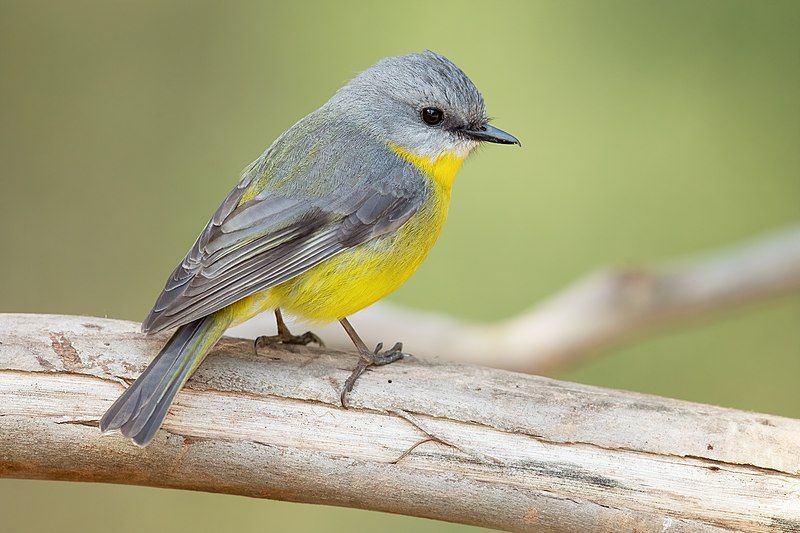
Songbirds, belonging to the order Passeriformes, encompass a vast and diverse group of birds characterized by their vocalizations, which include melodious songs. These birds, often called passerines, are known worldwide for their adaptability to various habitats.
Some well-known examples of songbirds include thrushes, warblers, sparrows, and finches. Their remarkable vocal talents are crucial in courtship, territory defense, and communication.
| Kingdom | Animalia |
| Phylum | Chordata |
| Clade | Eupasseres |
| Class | Aves |
| Order | Passeriformes |
12. Pileated Woodpecker (Dryocopus pileatus)
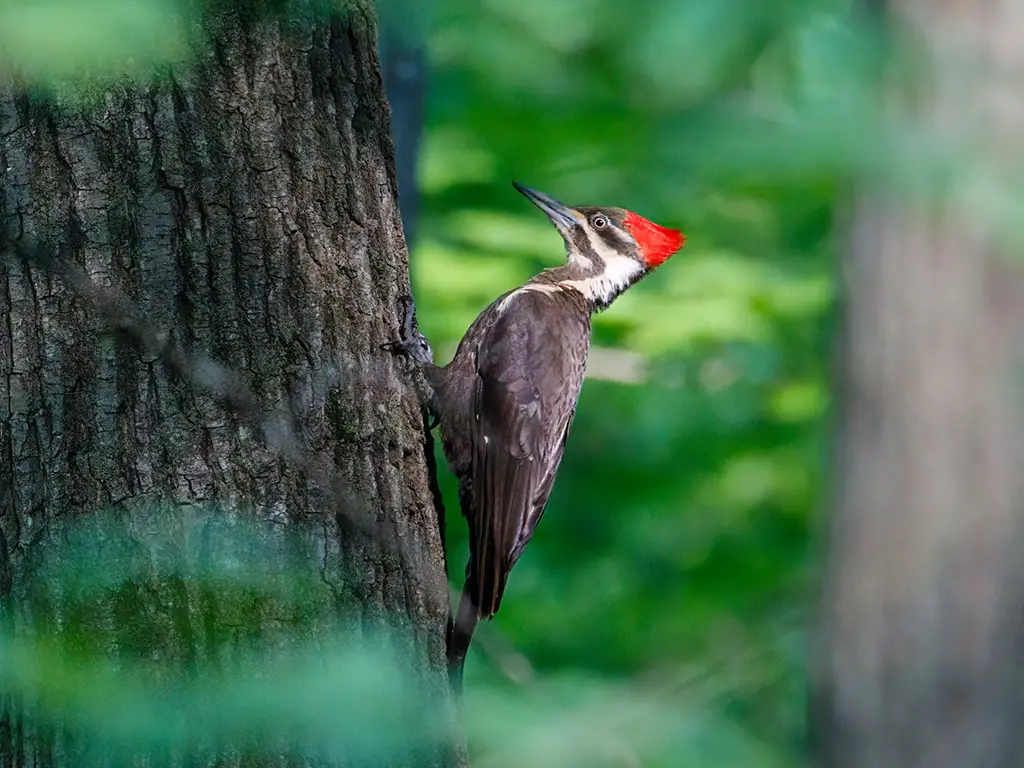
The Pileated Woodpecker is one of North America’s most impressive woodpecker species. Recognizable by its striking red crest and large size, it is often referred to as the “Woodland Elvis” due to its rock-and-roll appearance.
These woodpeckers inhabit mature forests and are skilled at excavating large, rectangular holes in search of insects and larvae.
Their loud, resonant calls and distinctive drumming echo through the woods. Pileated Woodpeckers are vital for forest ecosystems as cavity nesters and for their role in controlling insect populations.
| Kingdom | Animalia |
| Phylum | Chordata |
| Clade | Dinosauria |
| Class | Aves |
| Order | Piciformes |
| Family | Picidae |
| Genus | Dryocopus |
| Species | D. pileatus |
13. Common Redpoll (Acanthis flammea)
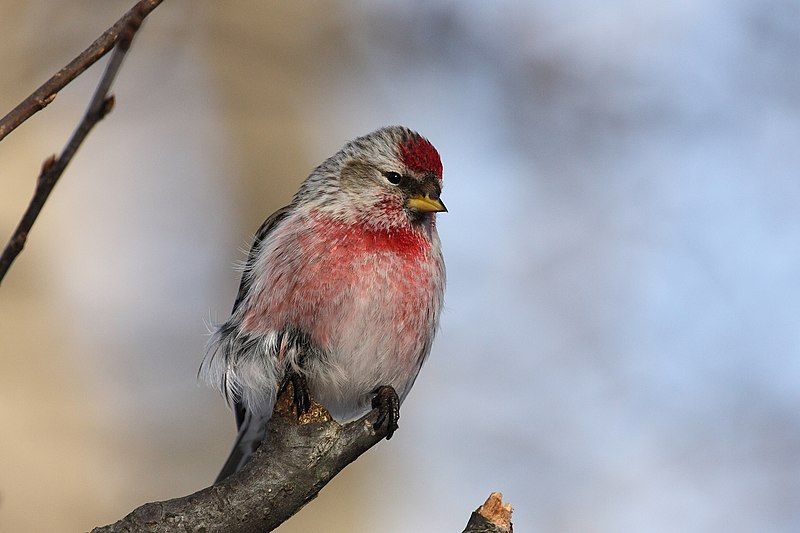
The Common Redpoll is a small finch species known for its winter visits to North America. These charming birds display a crimson forehead, a black chin, and a streaked brownish body.
They feed primarily on seeds, with a particular fondness for birch and alder seeds. During the winter, they form large flocks and are often found at bird feeders, bringing a burst of color to snowy landscapes.
Their cheerful, tinkling calls and acrobatic feeding behavior make them a delight for bird enthusiasts.
| Kingdom | Animalia |
| Phylum | Chordata |
| Clade | Dinosauria |
| Class | Aves |
| Order | Passeriformes |
| Family | Fringillidae |
| Genus | Acanthis |
| Species | A. flammea |
14. Pine Grosbeak (Pinicola enucleator)
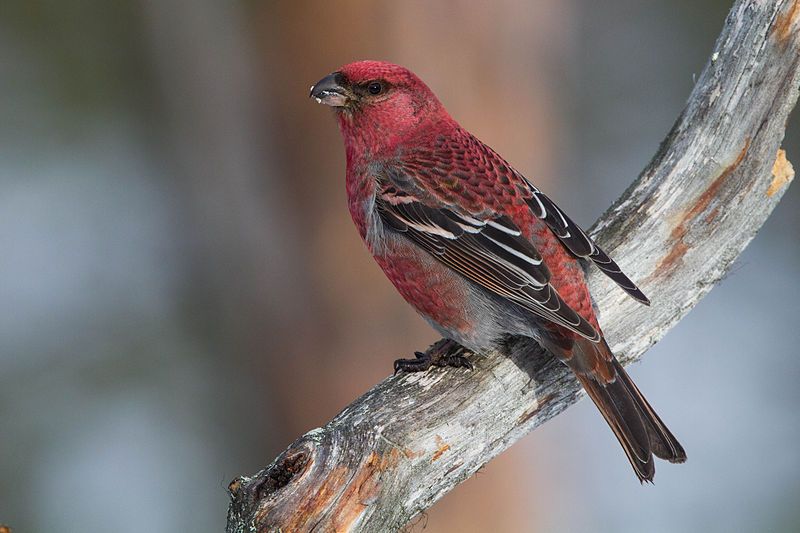
Pine Grosbeaks are plump, finch-like birds found in northern coniferous forests. Males boast a vibrant red plumage with a distinctive, heavy bill.
These frugivorous birds have a penchant for consuming fruits, berries, and seeds, making them important dispersers of plant seeds in their ecosystems.
Their gentle, warbling song adds a melodic touch to the quiet winter woods. Pine Grosbeaks are known for their irruptive behavior, moving southward in search of food when their northern habitats become scarce.
Their beauty and adaptability make them a sought-after sight for birdwatchers.
| Kingdom | Animalia |
| Phylum | Chordata |
| Clade | Dinosauria |
| Class | Aves |
| Order | Passeriformes |
| Family | Fringillidae |
| Genus | Pinicola |
| Species | P. enucleator |
15. Evening Grosbeak (Coccothraustes vespertinus)
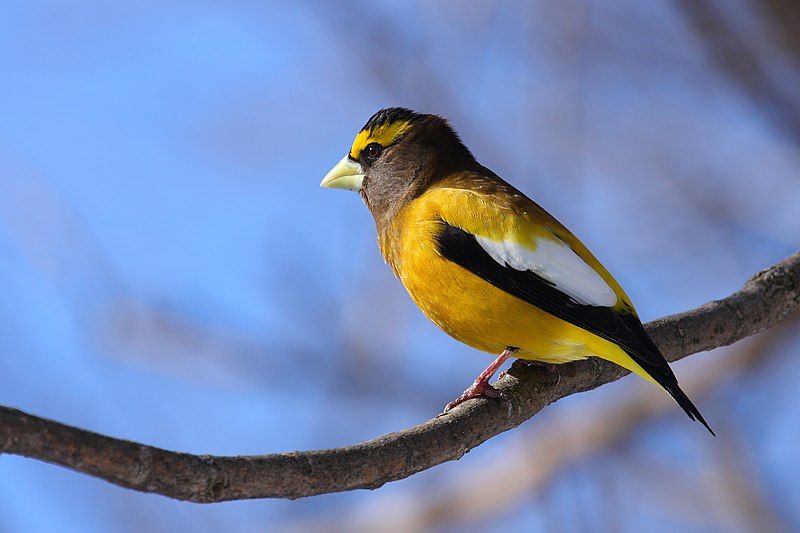
The Evening Grosbeak is a striking songbird with a vibrant yellow body, black wings, and a massive bill. These birds are named for their evening calls, which are reminiscent of creaky gates.
Evening Grosbeaks primarily feed on seeds, fruits, and insects. Their population is known for irregular movements, with occasional irruptions that bring them to new areas for food.
These birds often visit bird feeders in large flocks during their irruptive years, making them a thrilling sight for bird enthusiasts.
Evening Grosbeaks add a splash of color and a touch of excitement to North American forests and backyards.
| Kingdom | Animalia |
| Phylum | Chordata |
| Clade | Dinosauria |
| Class | Aves |
| Order | Passeriformes |
| Family | Fringillidae |
| Genus | Hesperiphona |
| Species | H. vespertina |
16. Purple Finch (Haemorhous purpureus)
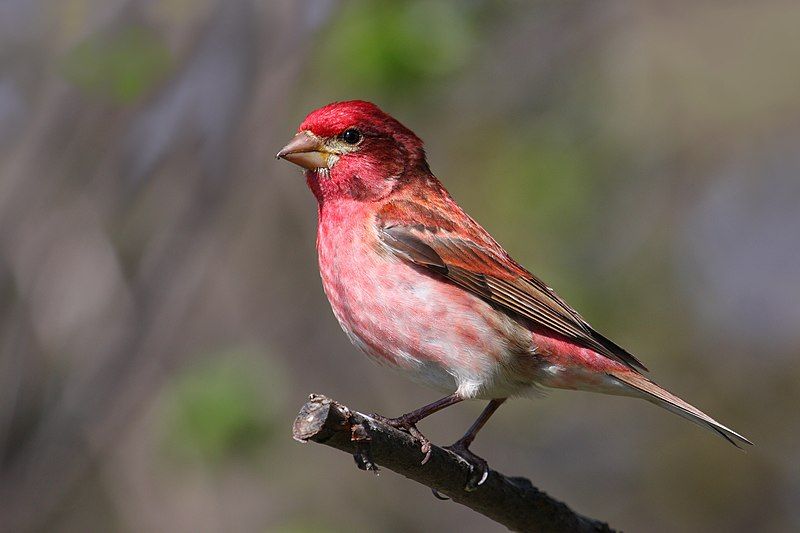
The Purple Finch is a delightful songbird known for its vibrant plumage and melodious tunes. Males display a rosy-red color on their head, throat, and breast, while females have a more subdued appearance.
These finches are primarily found in North America and prefer woodlands, gardens, and urban areas. Their diet consists of seeds, berries, and insects. Purple Finches are known for their cheerful, warbling songs, adding musical notes to their surroundings.
They are frequent visitors to bird feeders, especially during the winter months. Their striking appearance and charming calls make them a favorite among birdwatchers and backyard enthusiasts.
| Kingdom | Animalia |
| Phylum | Chordata |
| Clade | Dinosauria |
| Class | Aves |
| Order | Passeriformes |
| Family | Fringillidae |
| Genus | Haemorhous |
| Species | H. purpureus |
17. House Finch (Haemorhous mexicanus)
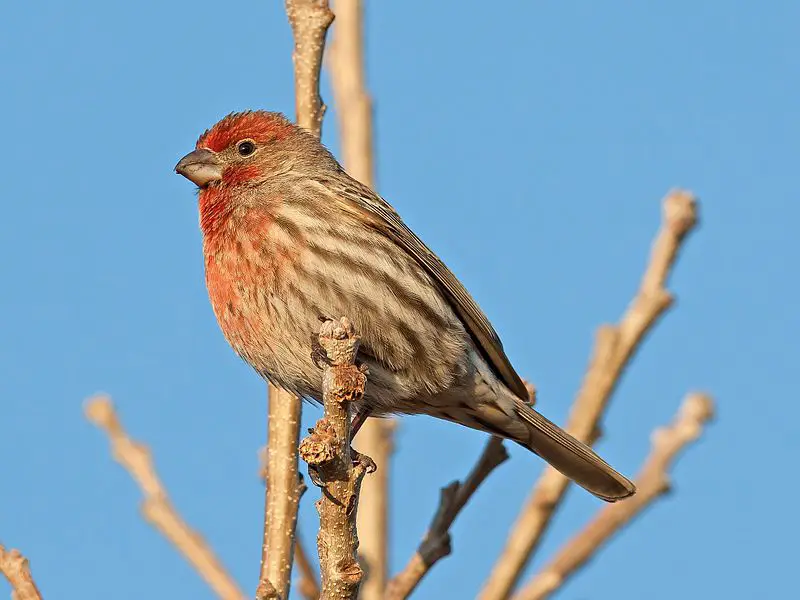
The House Finch is a small, adaptable bird native to western North America. These finches have thrived in urban and suburban environments across the continent.
House Finches come in various plumage colors, with males displaying red plumage on their throats and heads during the breeding season.
They are known for their cheerful, warbling songs and can be found in large flocks. Their diet primarily consists of seeds, but they also feed on fruits and small insects.
These finches are frequent visitors to bird feeders, where their colorful presence and melodious calls are a source of delight for bird enthusiasts.
| Kingdom | Animalia |
| Phylum | Chordata |
| Clade | Dinosauria |
| Class | Aves |
| Order | Passeriformes |
| Family | Fringillidae |
| Genus | Haemorhous |
| Species | H. mexicanus |
18. Red-Bellied Woodpecker (Melanerpes carolinus)
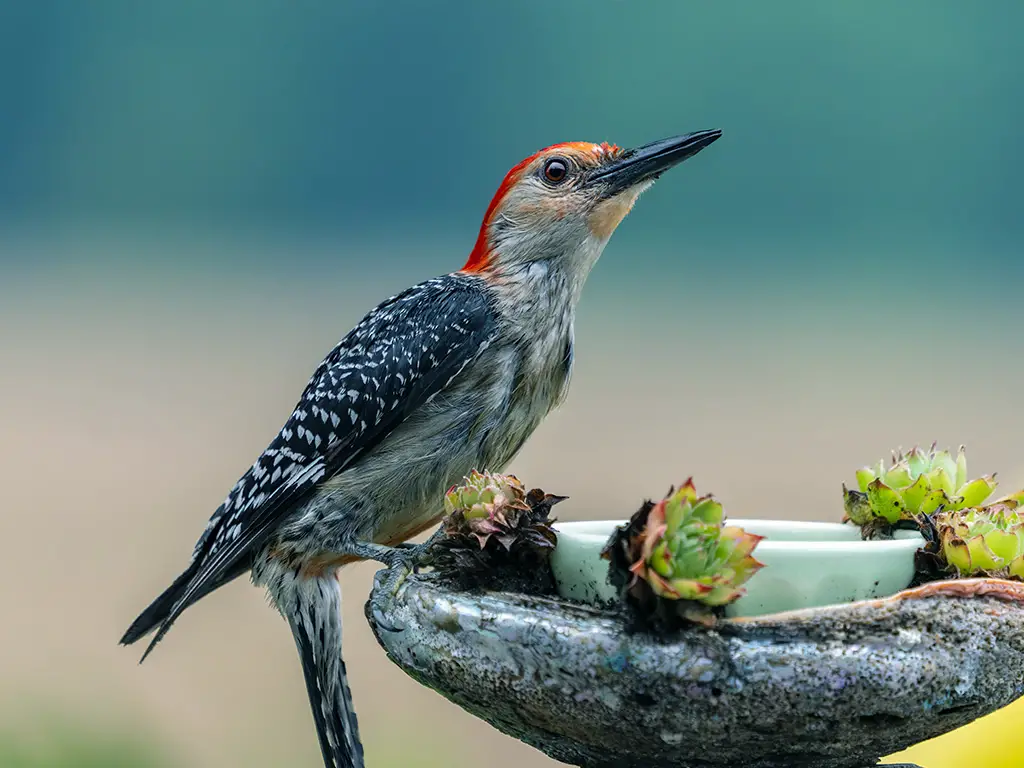
Despite its name, the Red-Bellied Woodpecker is known for the red cap on the back of its head rather than its belly. These woodpeckers are native to North America and are often found in forests, woodlands, and suburban areas.
They have a varied diet, including insects, fruits, and nuts. Their distinctive calls and drumming sounds are a common presence in eastern woodlands.
Red-bellied woodpeckers are known for their acrobatic foraging, clinging to tree trunks and branches in search of food. They are cavity nesters, often using old tree holes or nest boxes, and their presence is a testament to the health of forest ecosystems.
| Kingdom | Animalia |
| Phylum | Chordata |
| Clade | Dinosauria |
| Class | Aves |
| Order | Piciformes |
| Family | Picidae |
| Genus | Melanerpes |
| Species | M. carolinus |
19. American Robin (Turdus migratorius)
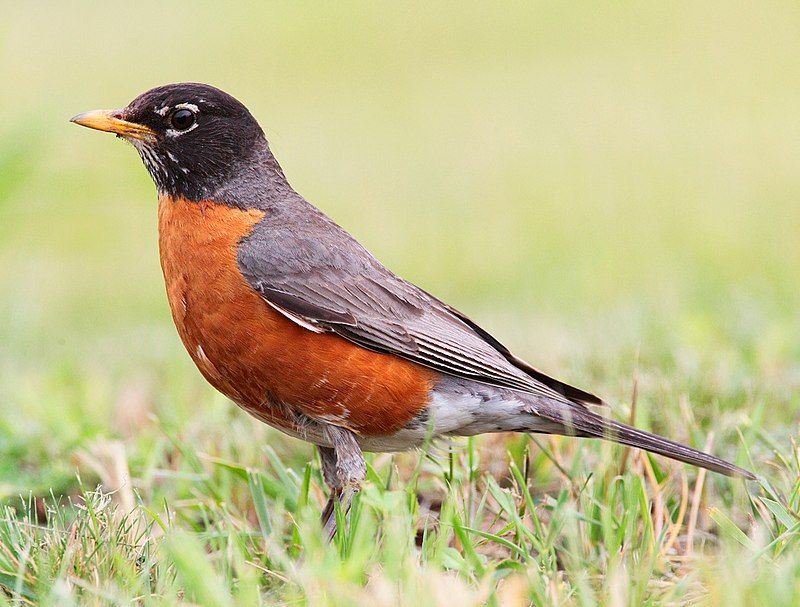
The American Robin is a familiar sight across North America, known for its cheerful red-orange breast and melodious song.
These birds are often associated with the arrival of spring and are found in various habitats, including gardens, woodlands, and urban areas.
American Robins primarily feed on insects, earthworms, and fruits, and they are often seen foraging on lawns and in search of their favorite meals.
Their rich, flute-like songs add a delightful soundtrack to the outdoors, and their bright appearance is a symbol of hope and renewal.
| Kingdom | Animalia |
| Phylum | Chordata |
| Clade | Dinosauria |
| Class | Aves |
| Order | Passeriformes |
| Family | Turdidae |
| Genus | Turdus |
| Species | T. migratorius |
20. Mourning Dove (Zenaida macroura)
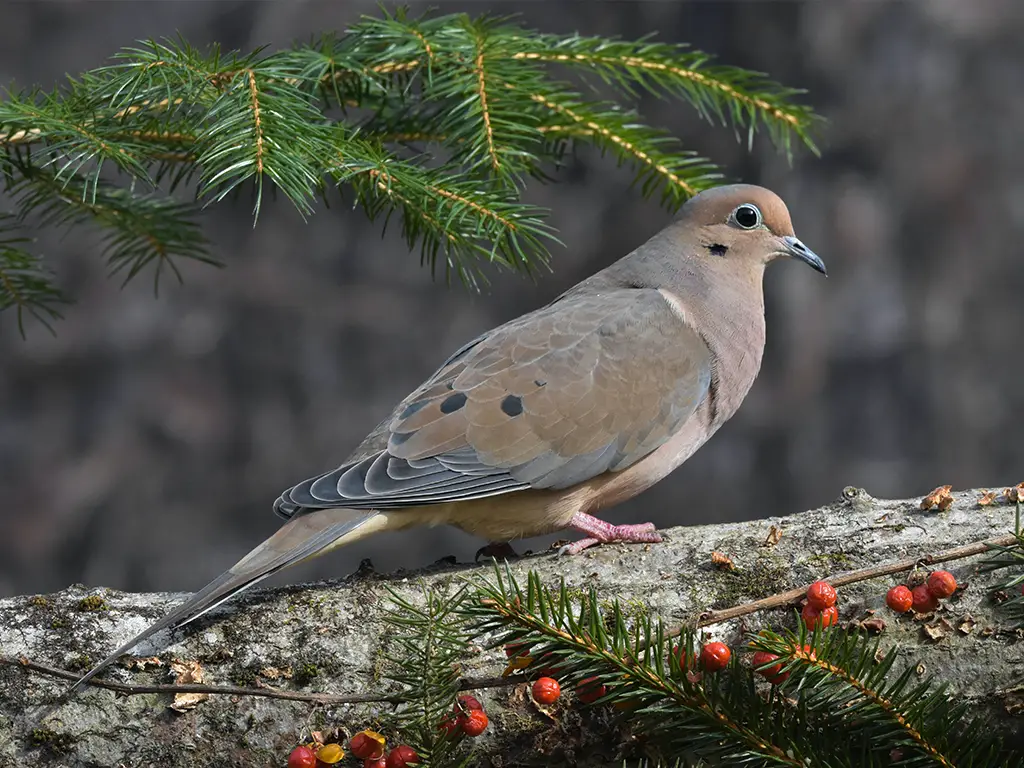
The Mourning Dove is a gentle and widespread bird known for its soft cooing calls. These doves are found throughout North America and inhabit various environments, from farmlands to suburban neighborhoods.
They have a subtle, gray-brown plumage with a distinct, pointed tail. Mourning Doves primarily feed on seeds and grains, making them frequent visitors to bird feeders.
Their mournful yet soothing cooing sounds are often heard in the early morning and evening, earning them their name.
These doves are monogamous and often seen in pairs. Their presence adds a sense of tranquility to outdoor spaces and gardens.
| Kingdom | Animalia |
| Phylum | Chordata |
| Clade | Dinosauria |
| Class | Aves |
| Order | Columbiformes |
| Family | Columbidae |
| Genus | Zenaida |
| Species | Z. macroura |
21. Red-Breasted Nuthatch (Sitta canadensis)
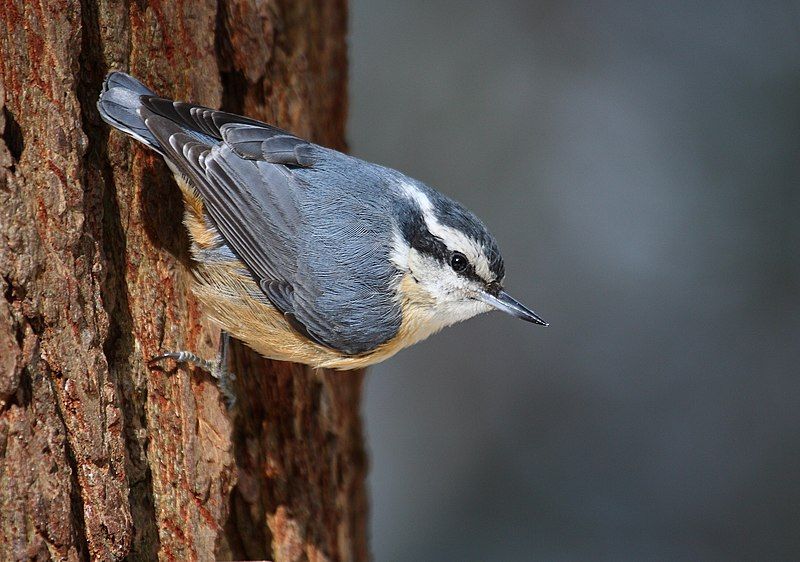
The Red-Breasted Nuthatch is a small and agile bird native to North America. These nuthatches are easily recognized by their bluish-gray plumage and vibrant reddish-orange throat and breast.
They inhabit coniferous forests and are adept at climbing tree trunks and branches, often seen upside down or sideways, as they forage for insects, seeds, and nuts. Their nasal and repetitive calls sound like a tiny horn honking.
Red-breasted nuthatches are cavity nesters, utilizing old tree holes and nest boxes for breeding. Their energetic and acrobatic behavior makes them a fascinating species to observe in woodlands and gardens, especially among coniferous trees.
| Kingdom | Animalia |
| Phylum | Chordata |
| Clade | Dinosauria |
| Class | Aves |
| Order | Passeriformes |
| Family | Sittidae |
| Genus | Sitta |
| Species | S. canadensis |
22. Tufted Titmouse (Baeolophus bicolor)

The Tufted Titmouse is a charming, small songbird found in eastern North America. Known for their distinctive plumage, striking crests, and dark eyes, these birds are a delight to observe.
They inhabit woodlands and suburban areas, often visiting bird feeders for seeds, nuts, and insects. Tufted Titmice have a cheerful, whistling call and are known for their sociable nature, often seen in mixed flocks with other small birds.
They are cavity nesters and may use tree holes or nest boxes for breeding. Their lively presence and melodious songs add vibrancy to outdoor spaces, making them a favorite among bird enthusiasts.
| Kingdom | Animalia |
| Phylum | Chordata |
| Clade | Dinosauria |
| Class | Aves |
| Order | Passeriformes |
| Family | Paridae |
| Genus | Baeolophus |
| Species | B. bicolor |
23. American Crow (Corvus brachyrhynchos)
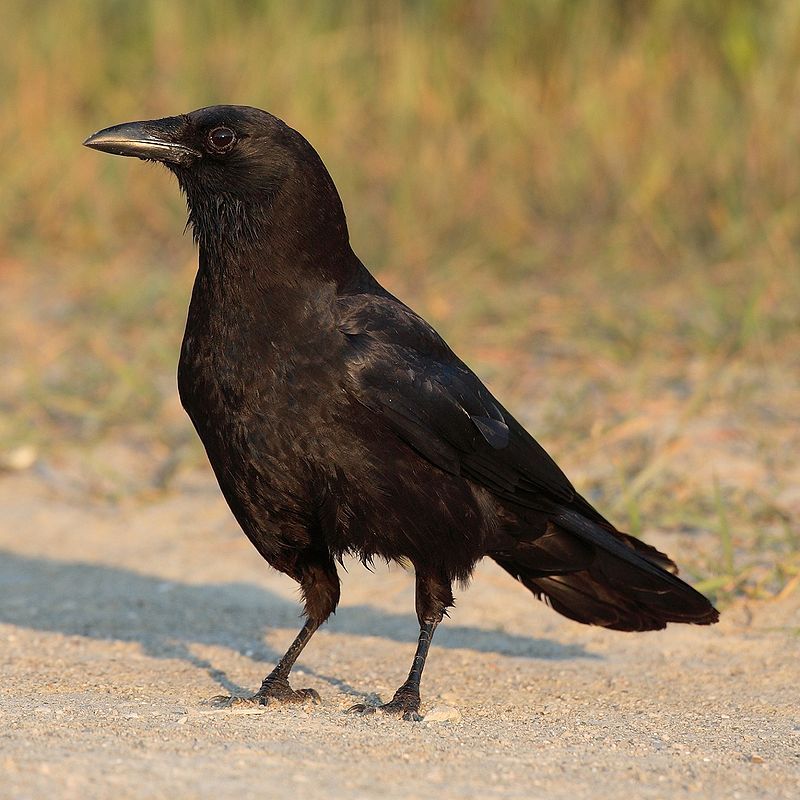
The American Crow is a highly intelligent and adaptable bird found across North America. These large, black birds are known for their distinctive cawing calls and keen problem-solving abilities.
They inhabit various environments, from urban areas to forests, and have a varied diet, including insects, small mammals, carrion, and even human food scraps.
American Crows are social birds, often seen in groups. Their strong association with death and the supernatural in folklore and literature has made them a symbol of mystery and intrigue.
Despite their sometimes controversial reputation, they play essential roles in ecosystems by cleaning up carrion and controlling insect populations.
| Kingdom | Animalia |
| Phylum | Chordata |
| Clade | Dinosauria |
| Class | Aves |
| Order | Passeriformes |
| Family | Corvidae |
| Genus | Corvus |
| Species | C. brachyrhynchos |
24. Common Starling (Sturnus vulgaris)
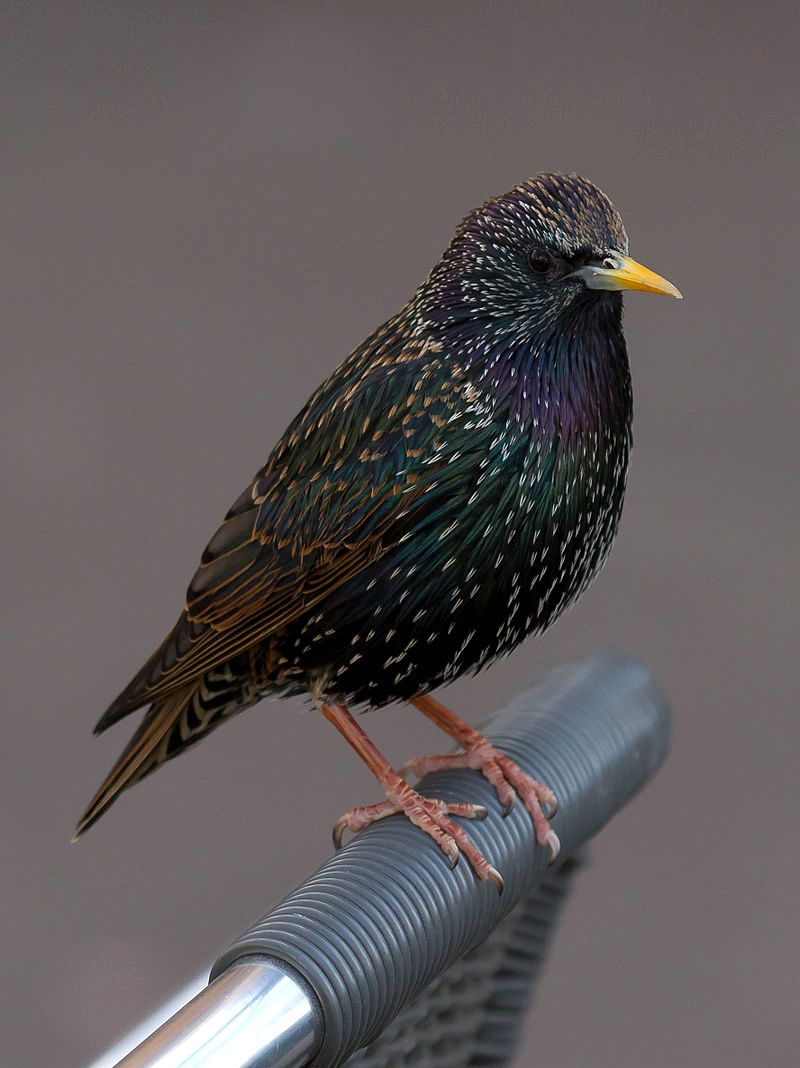
The Common Starling is a medium-sized songbird known for its iridescent plumage, which shifts in color depending on the light. These birds were introduced to North America and have thrived, forming large flocks in urban and suburban areas.
Starlings have a wide-ranging diet, including insects, fruits, and grains. They are skilled mimics, capable of imitating various sounds and even the songs of other birds.
Common Starlings are highly social and engage in impressive aerial displays called murmurations, where thousands of birds fly together in synchronized patterns.
While their adaptability and intelligence are remarkable, they are considered invasive in some regions due to their impact on native bird species.
| Kingdom | Animalia |
| Phylum | Chordata |
| Clade | Dinosauria |
| Class | Aves |
| Order | Passeriformes |
| Family | Sturnidae |
| Genus | Sturnus |
| Species | S. vulgaris |
25. Rock Dove (Columba livia)
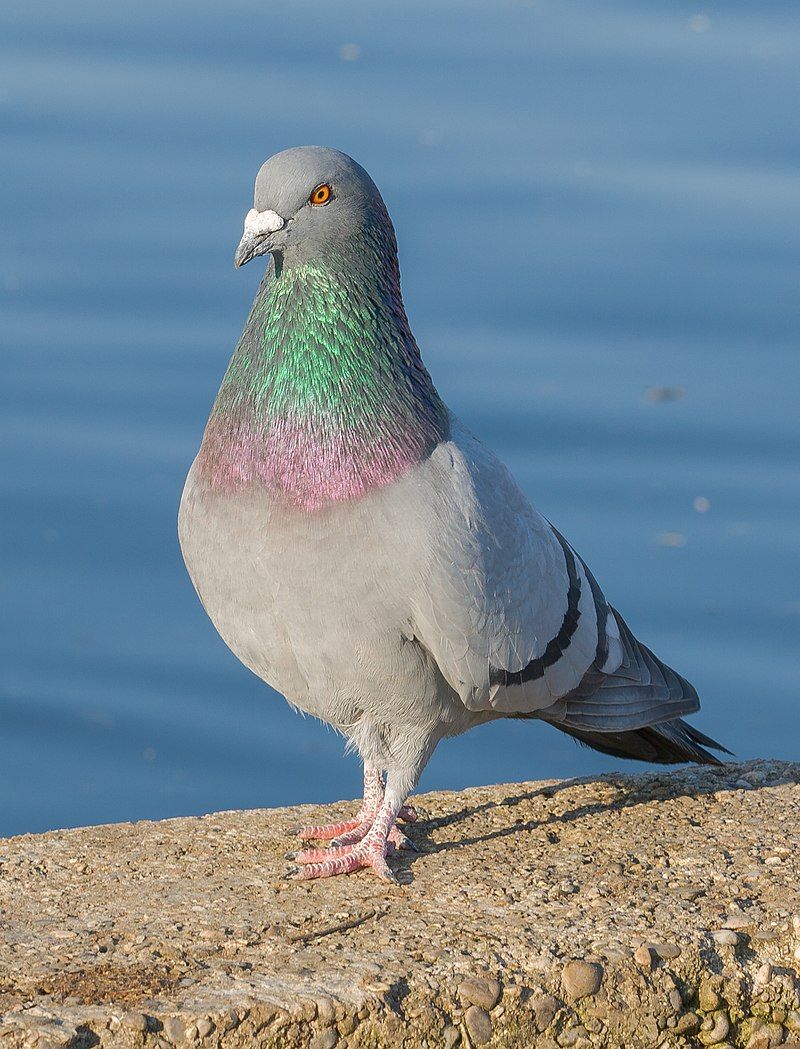
The Rock Dove, commonly known as the pigeon, is a ubiquitous bird found in cities and towns worldwide. These birds exhibit various plumage colors, including shades of gray, white, and iridescent green and purple.
Known for their distinctive cooing calls, pigeons are highly adaptable and thrive in urban environments, often nesting on buildings and bridges.
They primarily feed on grains and seeds but are opportunistic scavengers, often foraging for food scraps in urban areas.
Despite being common and sometimes overlooked, pigeons have a fascinating history, having been domesticated for thousands of years and playing roles in communication and wartime efforts.
| Kingdom | Animalia |
| Phylum | Chordata |
| Clade | Dinosauria |
| Class | Aves |
| Order | Columbiformes |
| Family | Columbidae |
| Genus | Columba |
| Species | C. livia |
26. Bald Eagle (Haliaeetus leucocephalus)
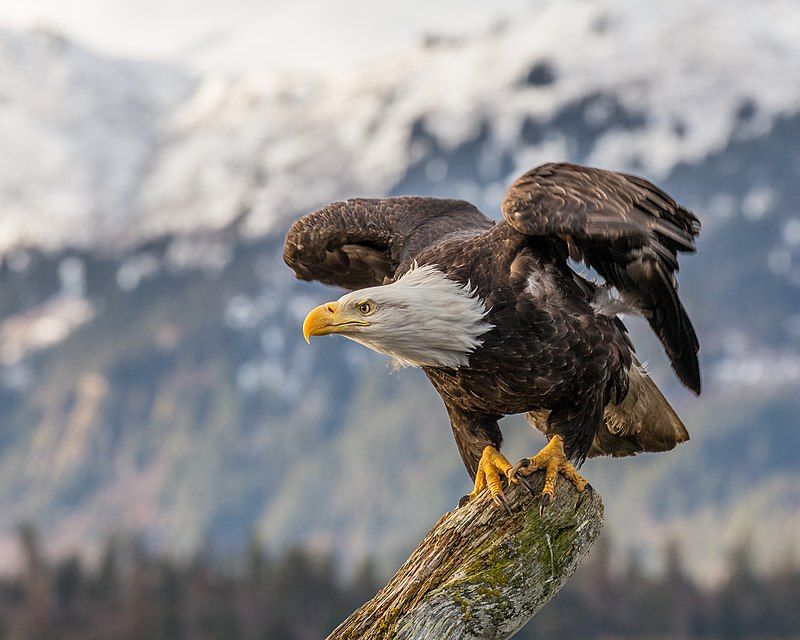
The Bald Eagle is a majestic raptor and the national emblem of the United States. These large birds of prey boast distinctive white heads and tails, along with powerful yellow beaks and talons.
Bald Eagles are primarily fish-eaters, often hunting near bodies of water, but they also consume other birds, mammals, and carrion.
These apex predators are known for their impressive aerial displays, including breathtaking courtship flights and territorial disputes.
Once endangered due to habitat loss and pesticide exposure, their population has rebounded thanks to conservation efforts.
Bald Eagles are symbols of freedom and strength, and their sight soaring over waterways is a powerful and awe-inspiring experience.
| Kingdom | Animalia |
| Phylum | Chordata |
| Clade | Dinosauria |
| Class | Aves |
| Order | Accipitriformes |
| Family | Accipitridae |
| Genus | Haliaeetus |
| Species | H. leucocephalus |
27. Red-Tailed Hawk (Buteo jamaicensis)
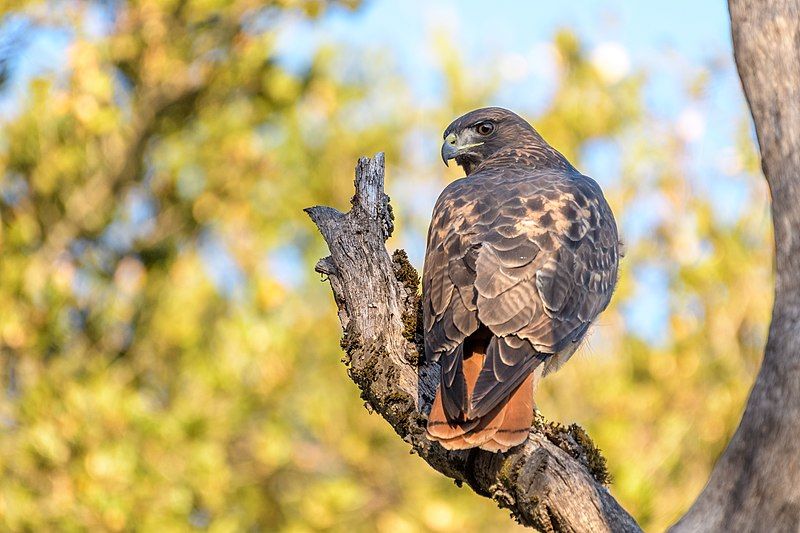
The Red-Tailed Hawk is one of North America’s most widespread and easily recognizable raptors. These hawks are known for their brick-red tails, contrasting with their dark plumage and pale underparts.
They inhabit various ecosystems, from open fields to forests, and are skilled hunters of small mammals, birds, and reptiles. Red-tailed hawks are often seen perched on high vantage points or soaring for prey.
Their piercing, scream-like calls are commonly used in movies and television to represent hawks and eagles, even though they have a more typical “kree-ee-ee” call in the wild. These raptors play vital roles in controlling rodent populations and are revered for their grace and hunting prowess.
| Kingdom | Animalia |
| Phylum | Chordata |
| Clade | Dinosauria |
| Class | Aves |
| Order | Accipitriformes |
| Family | Accipitridae |
| Genus | Buteo |
| Species | B. jamaicensis |
28. Rough-Legged Buzzard (Buteo lagopus)
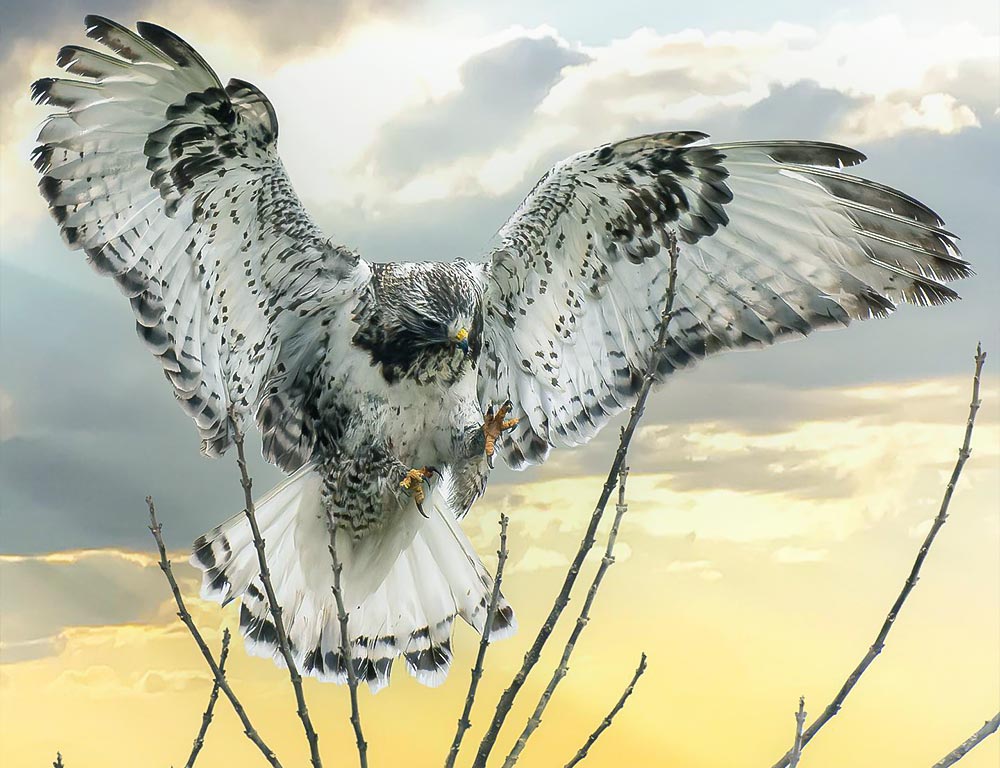
The Rough-Legged Buzzard, also known as the Rough-Legged Hawk, is a majestic bird of prey known for its distinctive feathered legs. Found in North America, Europe, and Asia, this raptor is perfectly adapted to northern tundra and open habitats.
Their plumage varies, with dark and light morphs, but all have dark belly bands. Rough-legged buzzards primarily hunt small mammals, such as voles and lemmings, and are known for their hovering hunting style.
They are often seen perched on poles or fence posts, scanning the ground for prey. These buzzards are migratory, traveling long distances between their breeding and wintering grounds.
Their appearance and hunting prowess make them a captivating sight for birdwatchers and wildlife enthusiasts.
| Kingdom | Animalia |
| Phylum | Chordata |
| Clade | Dinosauria |
| Class | Aves |
| Order | Accipitriformes |
| Family | Accipitridae |
| Genus | Buteo |
| Species | B. lagopus |
29. Snowy Owl (Bubo scandiacus)
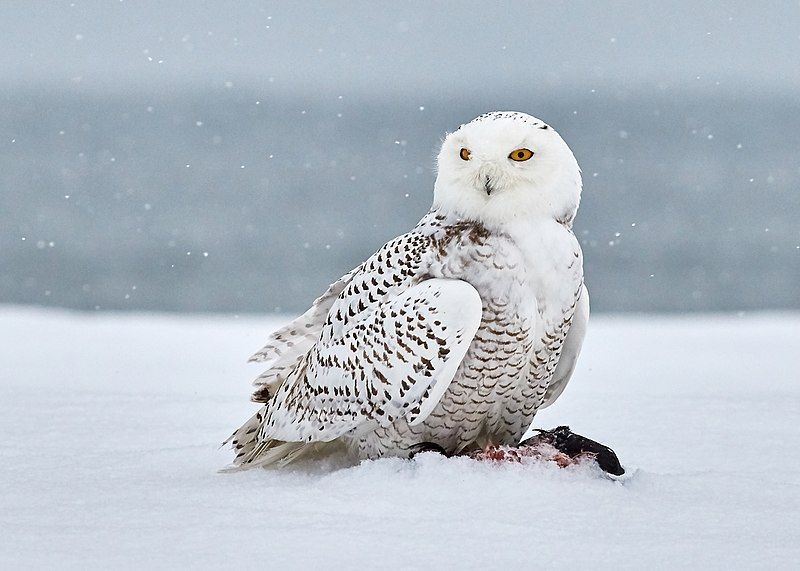
The Snowy Owl is an iconic Arctic owl with striking white plumage, making it one of the most recognizable birds of prey. Found in the Arctic regions of North America, Europe, and Asia, these owls are built for extreme cold and snowy conditions.
Snowy Owls are large and powerful predators, primarily hunting lemmings and other small mammals. Their yellow eyes and distinctive facial disks add to their captivating appearance.
Snowy Owls are known for irruptions and occasional migrations to southern regions when prey is scarce in the Arctic. They are also a symbol of the far north, often associated with the beauty and harshness of Arctic landscapes.
| Kingdom | Animalia |
| Phylum | Chordata |
| Clade | Dinosauria |
| Class | Aves |
| Order | Strigiformes |
| Family | Strigidae |
| Genus | Bubo |
| Species | B. scandiacus |
30. Northern Shrike (Lanius borealis)
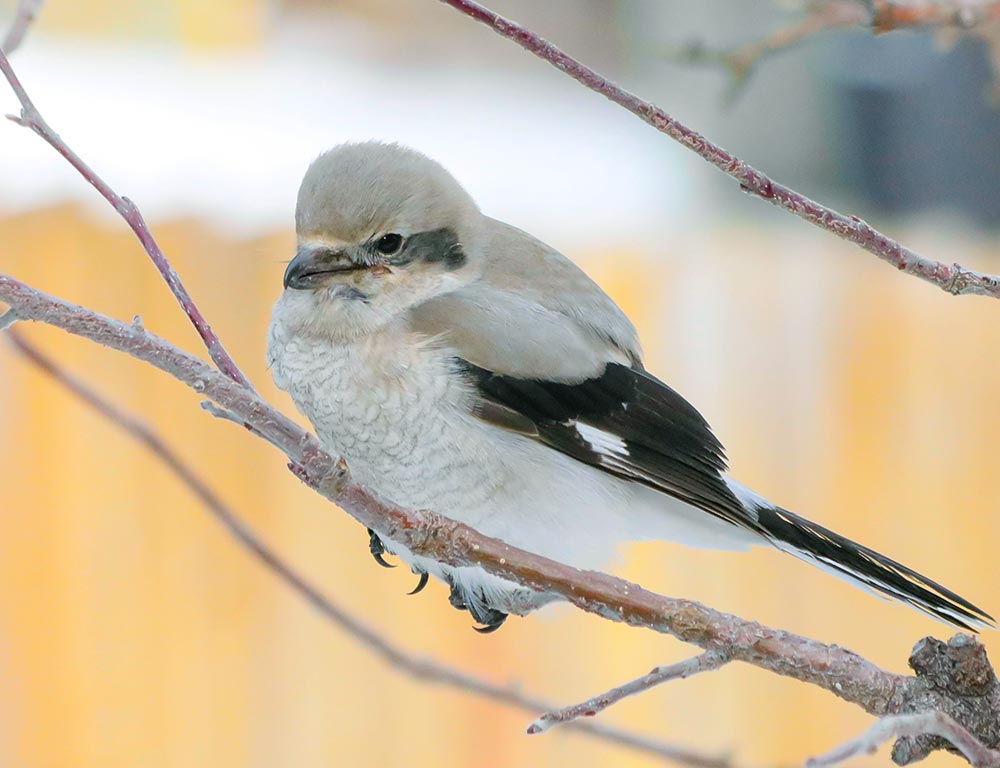
The Northern Shrike is a small, predatory songbird known for its striking black mask and hooked bill. These birds are found in northern North America, Europe, and Asia.
Northern Shrikes have a diet that includes small birds, mammals, and insects, which they often impale on thorns or barbed wire to save for later consumption.
They are fierce hunters despite their small size, and their bold black and white plumage helps them blend into snowy landscapes.
Northern Shrikes are known for their melodious yet haunting calls, which add an eerie element to the northern wilderness. They are often observed perched in open areas, scanning for prey.
| Kingdom | Animalia |
| Phylum | Chordata |
| Clade | Dinosauria |
| Class | Aves |
| Order | Passeriformes |
| Family | Laniidae |
| Genus | Lanius |
| Species | L. borealis |
31. Brown Creeper (Certhia americana)
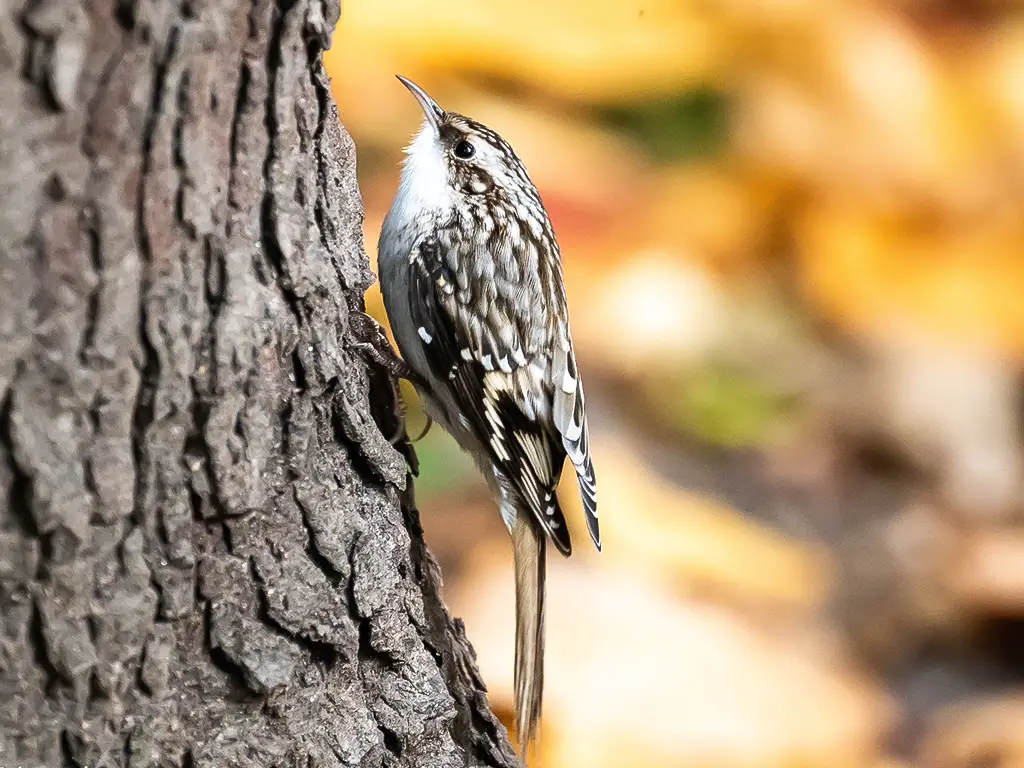
The Brown Creeper is a tiny, inconspicuous songbird found in North America. These birds have a mottled brown plumage that blends perfectly with tree bark, making them challenging to spot.
Brown Creepers are known for their unique feeding behavior, where they spiral up tree trunks, probing for insects and spiders hidden in the crevices of bark. Their long, curved bills are well-suited for this method of foraging.
Despite their small size and cryptic appearance, their high-pitched, melodious song adds a sweet note to forests during the breeding season. Brown Creepers are fascinating examples of avian adaptation to their woodland habitats.
| Kingdom | Animalia |
| Phylum | Chordata |
| Clade | Dinosauria |
| Class | Aves |
| Order | Passeriformes |
| Family | Certhiidae |
| Genus | Certhia |
| Species | C. americana |
32. Cedar Waxwing (Bombycilla cedrorum)
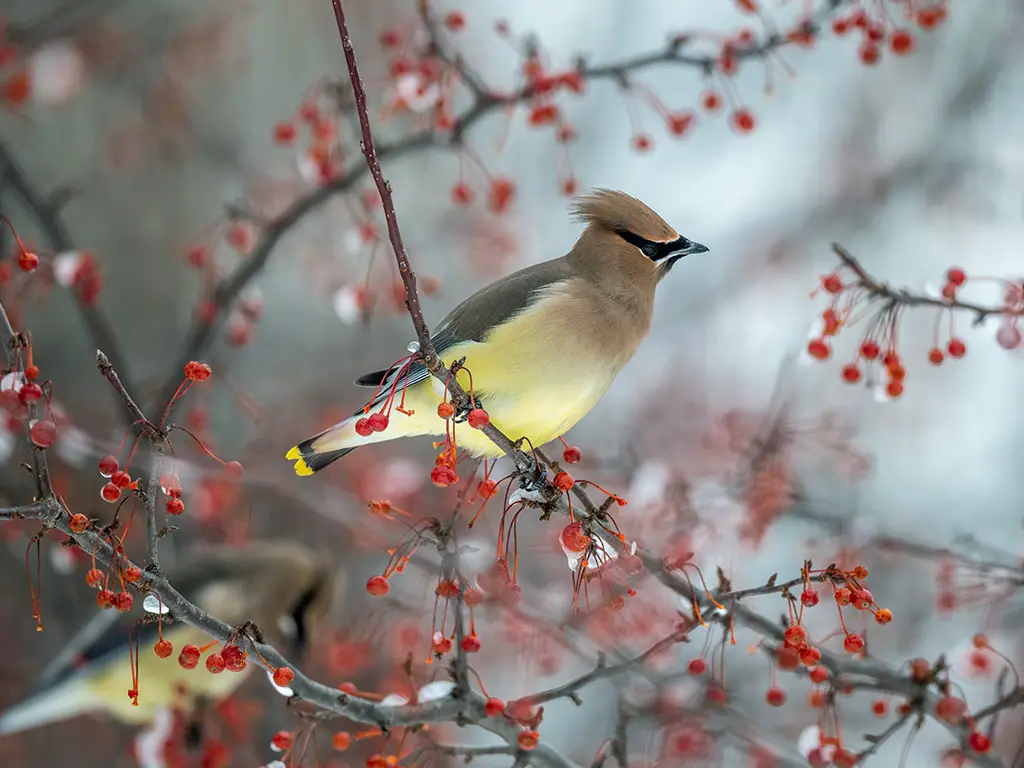
The Cedar Waxwing is a beautifully adorned songbird known for its sleek, silky plumage and striking wax-like wingtips. Found throughout North America, these birds are known for their frugivorous diet, feeding on various berries and fruits.
Their social nature often leads them to forage in flocks, and their synchronized flights are a mesmerizing sight. Cedar Waxwings is known for its high-pitched, trilling calls.
Their elegant appearance, with a black mask and vibrant yellow tail band, adds a touch of sophistication to gardens and woodlands.
These birds are admired for their gentle demeanor and distinctive appearance, making them a sought-after sight for birdwatchers and nature enthusiasts.
| Kingdom | Animalia |
| Phylum | Chordata |
| Clade | Dinosauria |
| Class | Aves |
| Order | Passeriformes |
| Family | Bombycillidae |
| Genus | Bombycilla |
| Species | B. cedrorum |
33. Cooper’s Hawk (Accipiter cooperii)
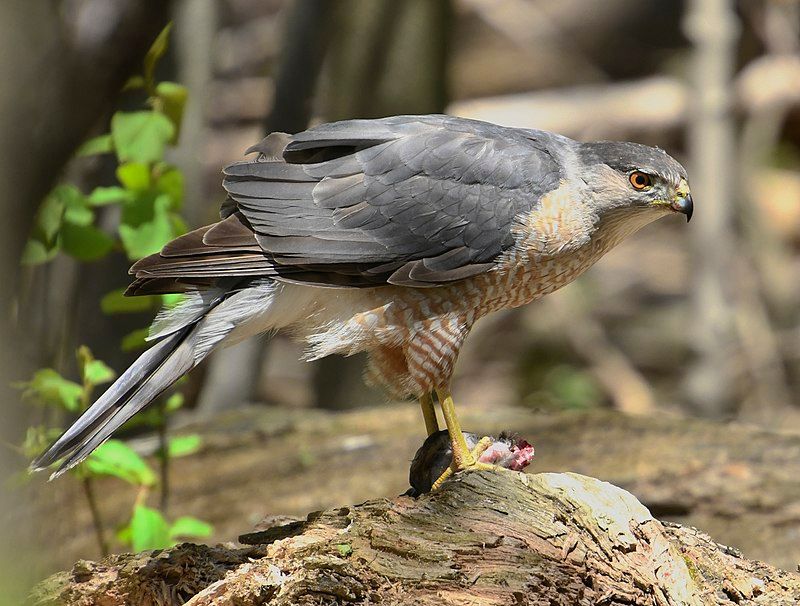
The Cooper’s Hawk is a medium-sized bird of prey found throughout North America. These agile hunters are known for their sharp beaks, long tails, and striking plumage.
Adults have blue-gray backs and reddish bars on their breasts, while juveniles exhibit brown and streaked patterns. Cooper’s Hawks are skilled at capturing other birds in flight, often hunting songbirds and pigeons.
They are secretive and prefer wooded areas, where they can utilize cover for stealthy hunting. Their calls include a series of high-pitched, rapid notes.
Cooper’s Hawks play a crucial role in controlling bird populations, and their presence adds an element of intrigue and drama to the birdwatching experience.
| Kingdom | Animalia |
| Phylum | Chordata |
| Clade | Dinosauria |
| Class | Aves |
| Order | Accipitriformes |
| Family | Accipitridae |
| Genus | Accipiter |
| Species | A. cooperii |
34. Red-Headed Woodpecker (Melanerpes erythrocephalus)
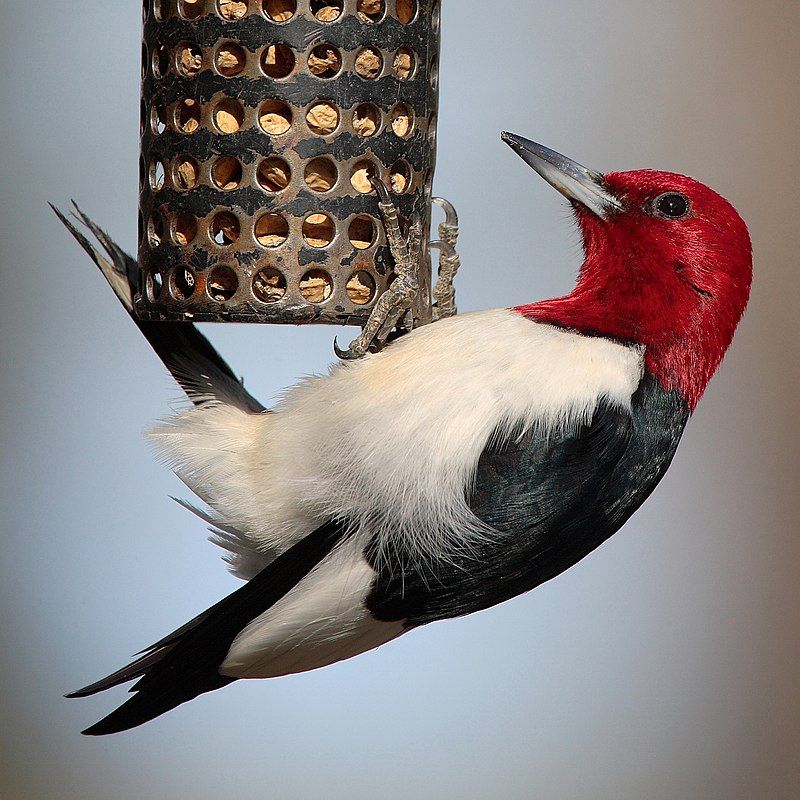
The Red-Headed Woodpecker is a striking and boldly colored bird native to North America. As the name suggests, it boasts vibrant red plumage on its head, neck, and throat. Its body is primarily white, with striking black wings and tail.
These woodpeckers are known for their aerial acrobatics and habit of catching insects mid-air. They are also skilled at storing food, often wedging nuts and insects into tree bark for later consumption.
Red-headed woodpeckers are often found in open woodlands and wood edges. Their calls include a variety of chattering and whistling sounds. Sadly, these woodpeckers face habitat loss and are considered a species of conservation concern in some regions.
| Kingdom | Animalia |
| Phylum | Chordata |
| Clade | Dinosauria |
| Class | Aves |
| Order | Piciformes |
| Family | Picidae |
| Genus | Melanerpes |
| Species | M. erythrocephalus |
35. Northern Flicker (Colaptes auratus)
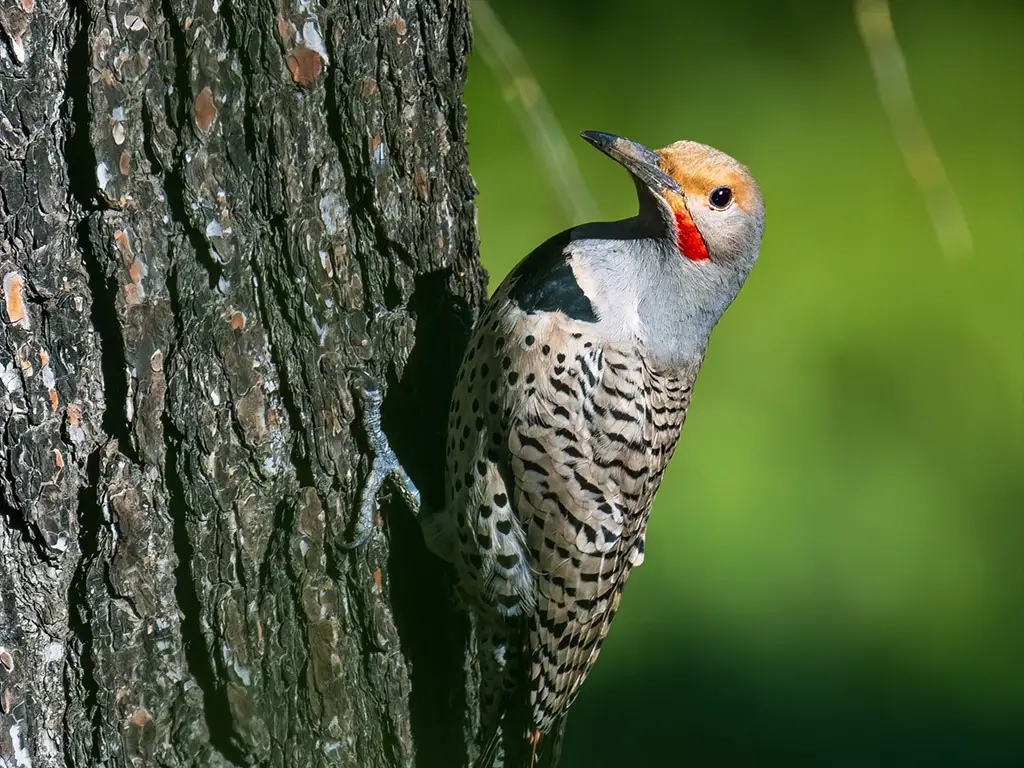
The Northern Flicker is a unique woodpecker species known for its ground-feeding habits and distinctive appearance.
These medium-sized woodpeckers have brownish plumage with prominent black markings on their wings, a white rump patch, and a spotted belly.
They have a conspicuous white rump patch visible in flight. Northern Flickers are often seen foraging for ants and other insects on the ground, using their long, slightly curved bills to probe for prey.
They also feed on berries and seeds. Their calls include a loud “wick-a-wick-a-wick” and a distinctive, rhythmic “flicker” call.
Northern Flickers are known for their elegant, undulating flight and are found across North America in various habitats, including open woodlands and suburban areas.
| Kingdom | Animalia |
| Phylum | Chordata |
| Clade | Dinosauria |
| Class | Aves |
| Order | Piciformes |
| Family | Picidae |
| Genus | Colaptes |
| Species | C. auratus |
36. Song Sparrow (Melospiza melodia)
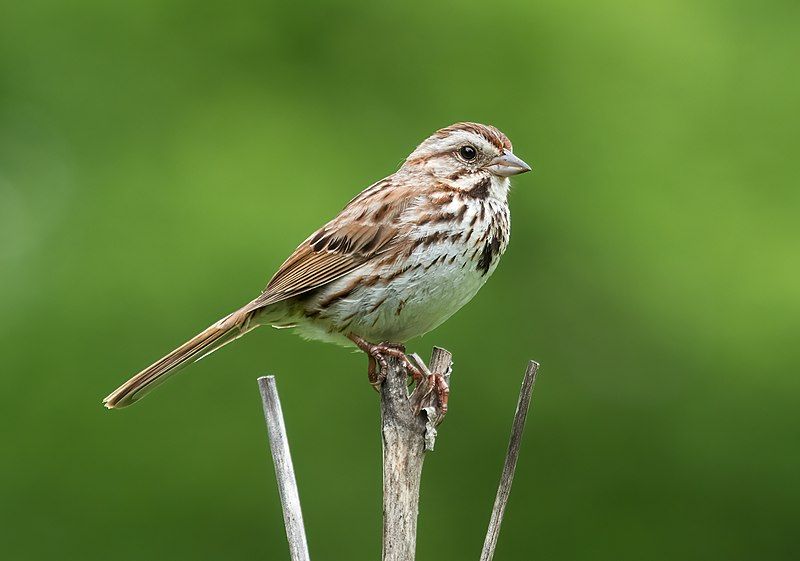
The Song Sparrow is a common and melodious songbird found throughout North America. Recognizable by their streaked brown plumage and distinctive dark central spot on their breast, they are known for their diverse songs, which can vary significantly among individuals and regions.
These sparrows inhabit many habitats, from wetlands and marshes to gardens and woodlands. They are primarily seed-eaters but also consume insects and berries.
Song Sparrows are highly adaptable and are often seen perched on shrubs or foraging on the ground. Their sweet, musical trills and chirps add a soothing ambiance to outdoor spaces, and they are a familiar and beloved sight for birdwatchers.
| Kingdom | Animalia |
| Phylum | Chordata |
| Clade | Dinosauria |
| Class | Aves |
| Order | Passeriformes |
| Family | Passerellidae |
| Genus | Melospiza |
| Species | M. melodia |
37. Great Horned Owl (Bubo virginianus)
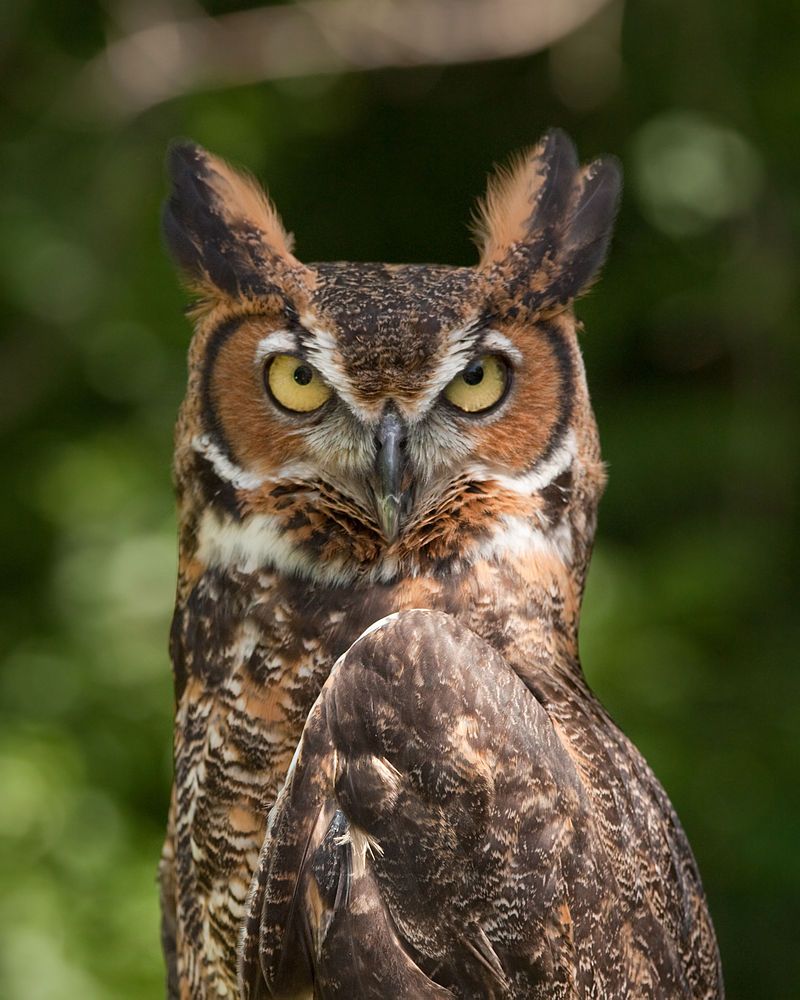
The Great Horned Owl is a magnificent bird of prey found across the Americas. With its large size, tufted “horns,” and piercing stare, it’s an iconic symbol of the wild.
These apex predators have versatile diets and hunt mammals, birds, and even reptiles. Their silent flight and strong talons make them stealthy and efficient hunters.
They adapt well to various habitats, from forests to deserts and cities. Their deep hooting calls echo through the night during the breeding season.
Revered for their wisdom and mystery, Great Horned Owls are crucial to maintaining ecological balance and stand as majestic symbols of the natural world.
| Kingdom | Animalia |
| Phylum | Chordata |
| Clade | Dinosauria |
| Class | Aves |
| Order | Strigiformes |
| Family | Strigidae |
| Genus | Bubo |
| Species | B. virginianus |
38. Common Grackle (Quiscalus quiscula)
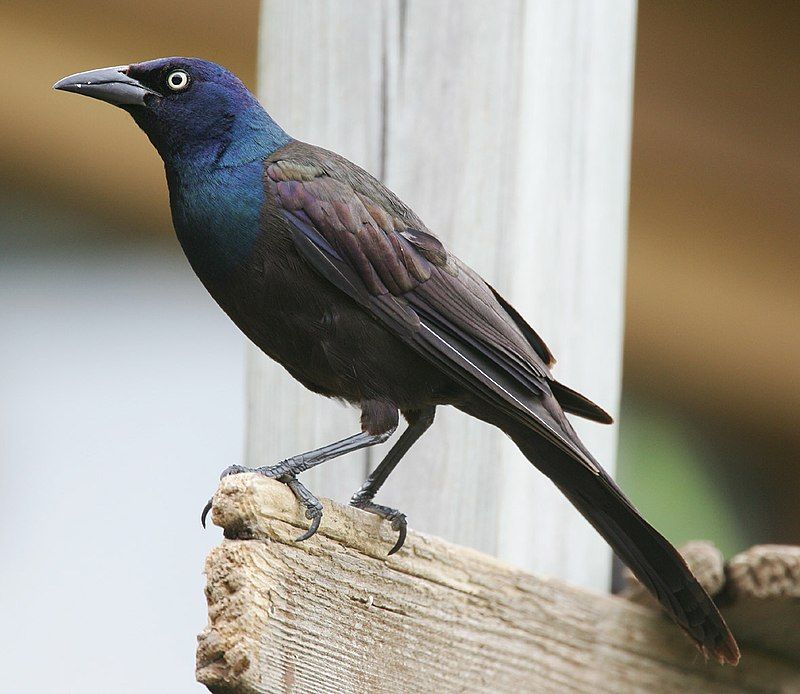
The Common Grackle is a striking and often raucous blackbird found throughout North America. These birds are known for their iridescent plumage, which gleams with green, blue, and purple hues in the sunlight.
Males are larger and more colorful than females. Common Grackles are omnivorous, feeding on insects, small vertebrates, seeds, fruits, and even garbage.
They are highly social birds and often gather in large, noisy flocks. Their calls include a variety of harsh, creaking sounds.
Common Grackles are often seen foraging on lawns and in urban areas, making them a common sight in parks and gardens.
Despite their sometimes pest-like behavior, they are a testament to nature’s adaptability and resilience in human-altered landscapes.
| Kingdom | Animalia |
| Phylum | Chordata |
| Clade | Dinosauria |
| Class | Aves |
| Order | Passeriformes |
| Family | Icteridae |
| Genus | Quiscalus |
| Species | Q. quiscula |
39. Barred Owl (Strix varia)
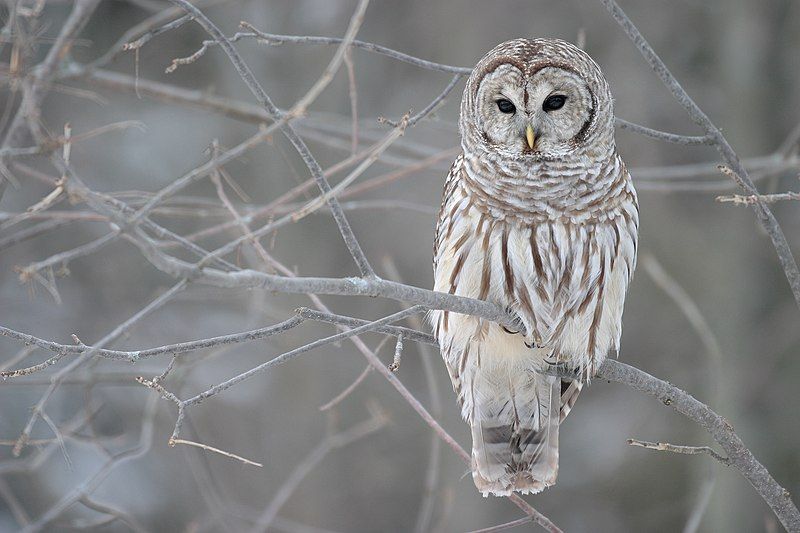
The Barred Owl is a striking medium-sized owl found in North America. Its name is derived from the distinctive barred pattern on its plumage, which consists of alternating dark and light stripes.
These owls have large, expressive brown eyes and lack ear tufts. They are known for their haunting, hooting calls that resonate through the forests they inhabit.
Barred Owls prefer dense woodlands and wetlands, primarily hunting small mammals, birds, and amphibians. Their silent flight allows them to approach prey stealthily.
These adaptable birds are often seen near human habitation. Their presence adds an air of mystery to the forested landscapes they call home.
| Kingdom | Animalia |
| Phylum | Chordata |
| Clade | Dinosauria |
| Class | Aves |
| Order | Strigiformes |
| Family | Strigidae |
| Genus | Strix |
| Species | S. varia |
40. Sharp-Shinned Hawk (Accipiter striatus)
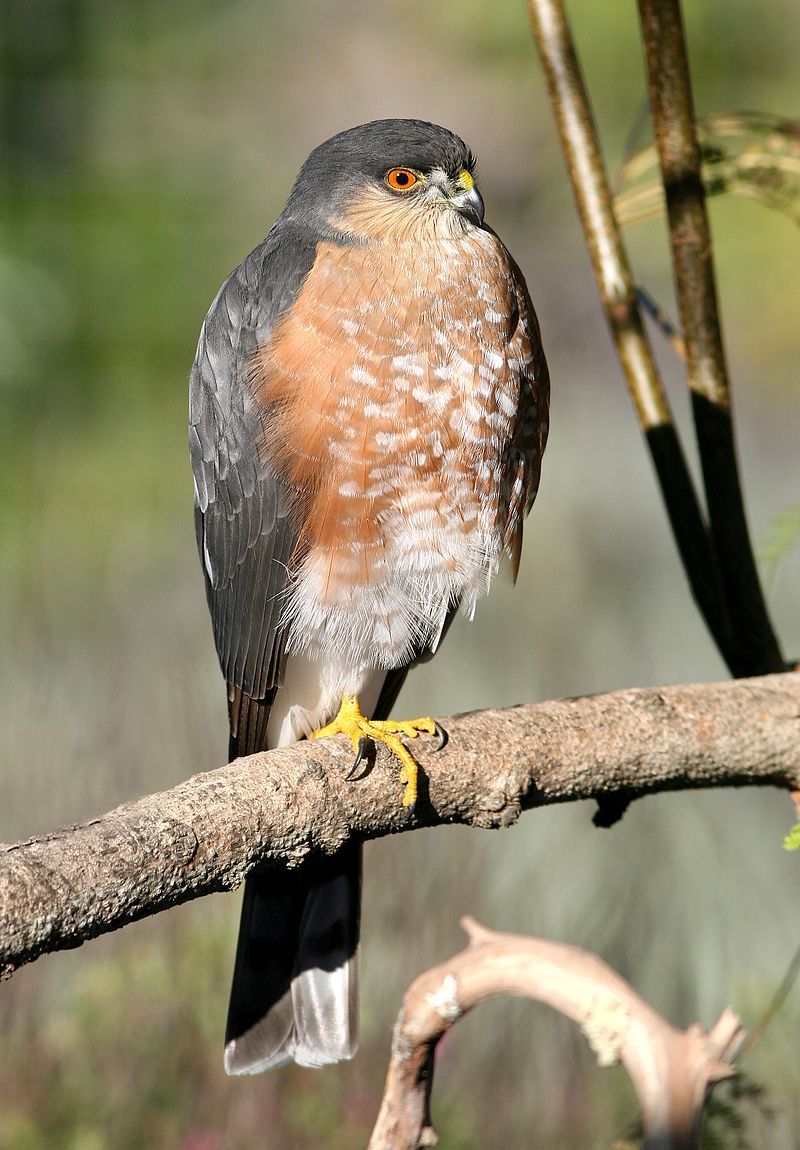
The Sharp-Shinned Hawk is a small but agile raptor known for its quick and stealthy hunting abilities. With short wings and a long tail, they are perfectly adapted for maneuvering through dense vegetation in pursuit of prey, primarily small birds and occasionally insects and rodents.
These hawks have slate-gray backs and reddish-brown barring on their breasts. They are found throughout North America and are often seen during migration seasons.
Sharp-Shinned Hawks are known for their rapid, flap-and-glide flight patterns and high-pitched calls. Their presence is a testament to the intricate predator-prey dynamics in ecosystems.
| Kingdom | Animalia |
| Phylum | Chordata |
| Clade | Dinosauria |
| Class | Aves |
| Order | Accipitriformes |
| Family | Accipitridae |
| Genus | Accipiter |
| Species | A. striatus |
41. Canada Goose (Branta canadensis)
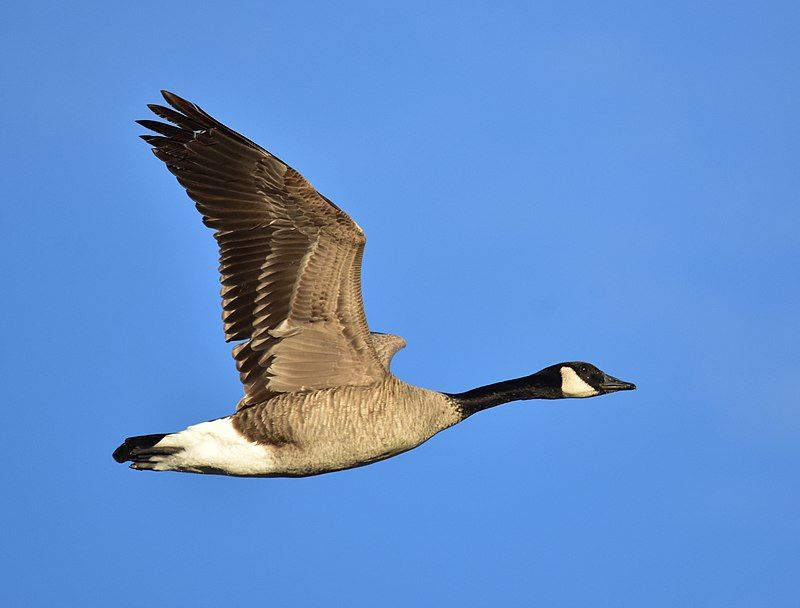
The Canada Goose is one of North America’s most recognizable waterfowl species. These large birds are known for their black necks and heads, white cheek patches, and brownish-gray bodies.
They are highly adaptable and inhabit various wetland habitats, lakes, rivers, and urban ponds. Canada Geese are herbivorous grazers, feeding on aquatic plants and grasses.
They are often seen in V-formation during migration, covering long distances between breeding and wintering grounds. Their loud, honking calls are a familiar sound in wetland areas.
Despite their beauty and grace in flight, they can sometimes be considered pests in urban areas due to their prolific populations.
| Kingdom | Animalia |
| Phylum | Chordata |
| Clade | Dinosauria |
| Class | Aves |
| Order | Anseriformes |
| Family | Anatidae |
| Genus | Branta |
| Species | B. canadensis |
42. Mallard (Anas platyrhynchos)
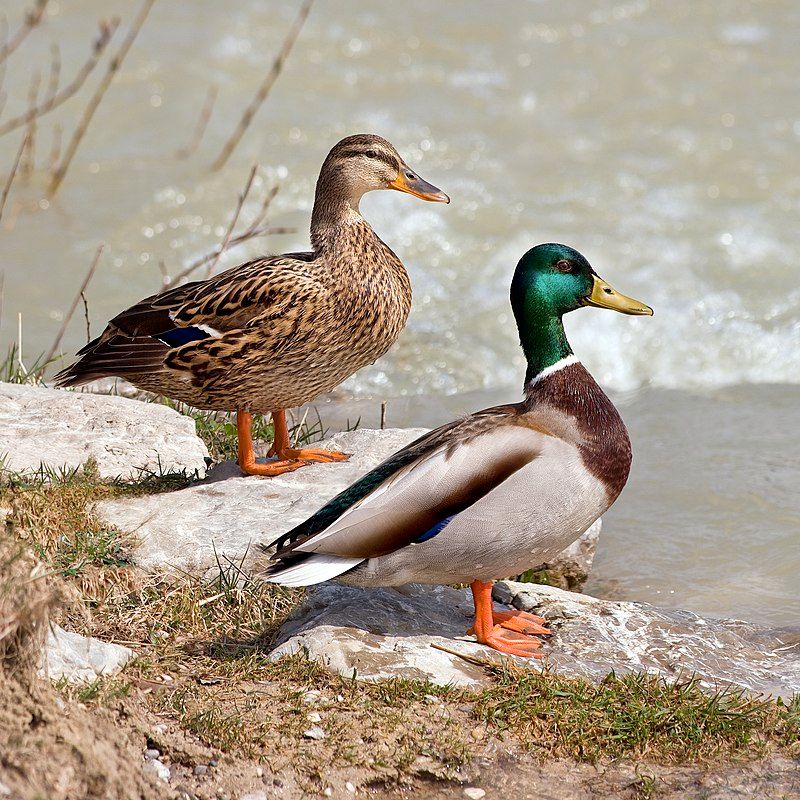
The Mallard is perhaps the most widely recognized and abundant duck species globally.
These waterfowl have striking sexual dimorphism, with males (drakes) displaying iridescent green heads, white neck rings, and chestnut-brown bodies, while females (hens) have mottled brown plumage.
Mallards are highly adaptable and can be found in various aquatic habitats, including ponds, lakes, rivers, and marshes.
They have an omnivorous diet, feeding on aquatic plants, insects, and small aquatic creatures. Mallards often dabble on the water’s surface or tipping forward to forage.
They are also popular in wildlife conservation and birdwatching activities, making them a beloved and familiar sight.
| Kingdom | Animalia |
| Phylum | Chordata |
| Clade | Dinosauria |
| Class | Aves |
| Order | Anseriformes |
| Family | Anatidae |
| Genus | Anas |
| Species | A. platyrhynchos |
43. Red-Winged Blackbird (Agelaius phoeniceus)
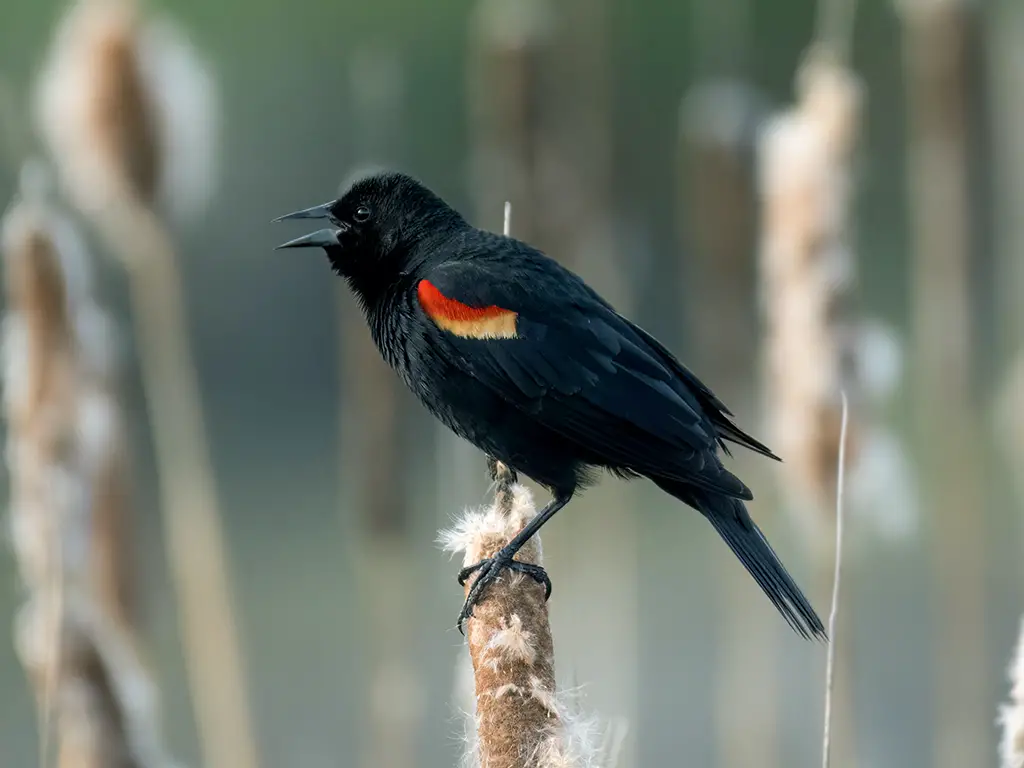
The Red-Winged Blackbird is a striking and highly territorial bird found across North America. Males are characterized by their glossy black plumage with vibrant red shoulder patches, while females are mottled brown.
These blackbirds inhabit wetlands, marshes, and grasslands, where they are known for their distinctive and melodious “conk-la-ree” songs.
They are omnivorous and feed on various foods, including insects, seeds, and aquatic plants.
Red-winged blackbirds are known for their aggressive defense of nesting territories and can be seen perched atop cattails or reeds, guarding their breeding grounds. Their presence adds color and energy to wetland ecosystems and symbolizes the changing seasons.
| Kingdom | Animalia |
| Phylum | Chordata |
| Clade | Dinosauria |
| Class | Aves |
| Order | Passeriformes |
| Family | Icteridae |
| Genus | Agelaius |
| Species | A. phoeniceus |
44. Eastern Screech Owl (Megascops asio)
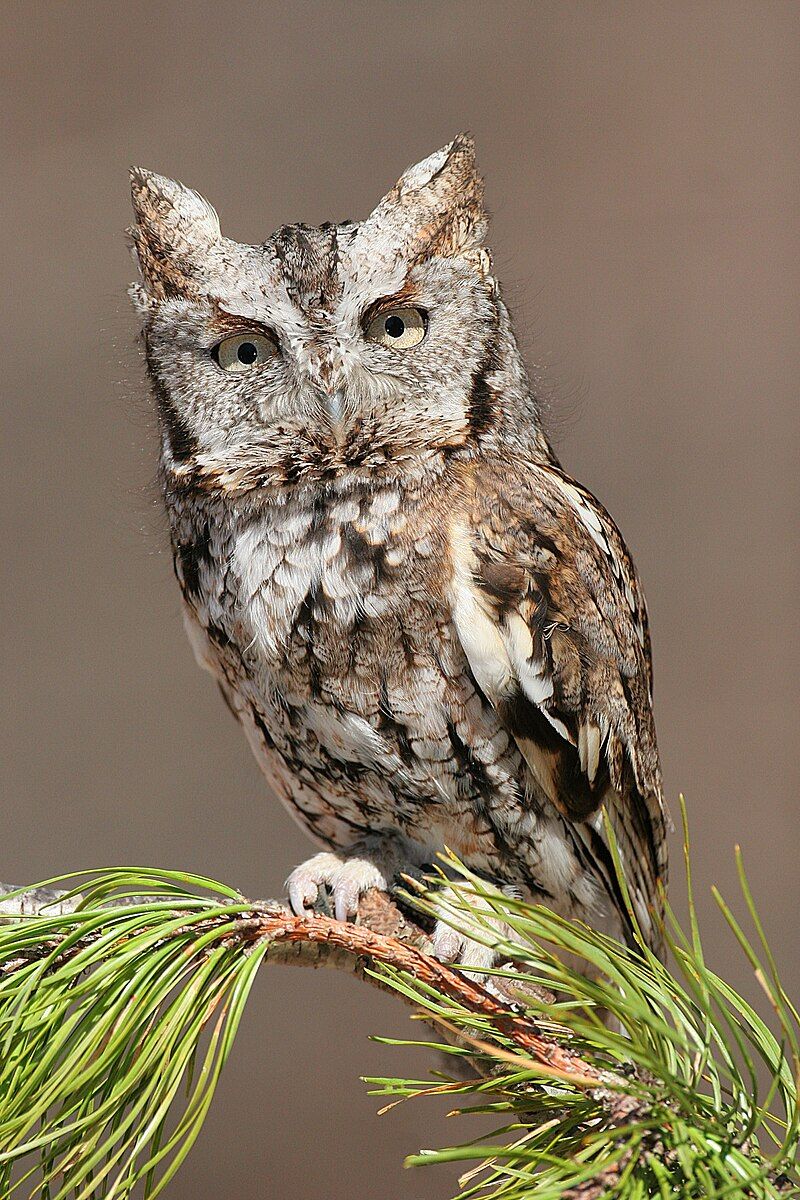
The Eastern Screech Owl is a small, adaptable owl species native to eastern North America. Despite its diminutive size, this owl is a formidable predator of insects, small mammals, and birds.
Eastern Screech Owls come in two color morphs: red and gray. The red morph has rust-colored plumage, while the gray morph is grayish-brown with intricate camouflage patterns.
These owls have distinctive ear tufts and piercing yellow eyes. They are often heard emitting haunting, trill-like whinnying calls during the night.
Eastern Screech Owls are cavity nesters, utilizing old woodpecker holes or nest boxes for shelter. Their ability to thrive in various habitats, from woodlands to urban areas, makes them a fascinating and elusive species for birdwatchers.
| Kingdom | Animalia |
| Phylum | Chordata |
| Clade | Dinosauria |
| Class | Aves |
| Order | Strigiformes |
| Family | Strigidae |
| Genus | Megascops |
| Species | M. asio |
45. Red Crossbill (Loxia curvirostra)
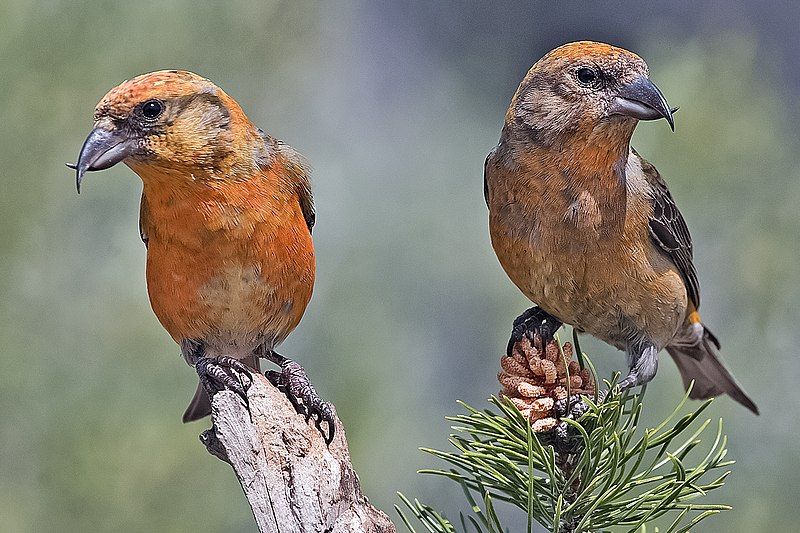
The Red Crossbill is a finch species known for its unique bill adaptation, which is crossed at the tips, allowing it to pry open conifer cones and access the seeds inside.
These birds exhibit sexual dimorphism in their plumage, with males typically displaying shades of red and females being greenish-yellow. Red Crossbills are found in coniferous forests across North America.
They are highly nomadic and can travel long distances for suitable cone crops. Their calls are characterized by a series of musical, warbling notes.
These finches are a remarkable example of avian adaptation to their specialized diet and are known for their unpredictable movements and feeding behavior.
| Kingdom | Animalia |
| Phylum | Chordata |
| Clade | Dinosauria |
| Class | Aves |
| Order | Passeriformes |
| Family | Fringillidae |
| Genus | Loxia |
| Species | L. curvirostra |
46. Great Grey Owl (Strix nebulosa)
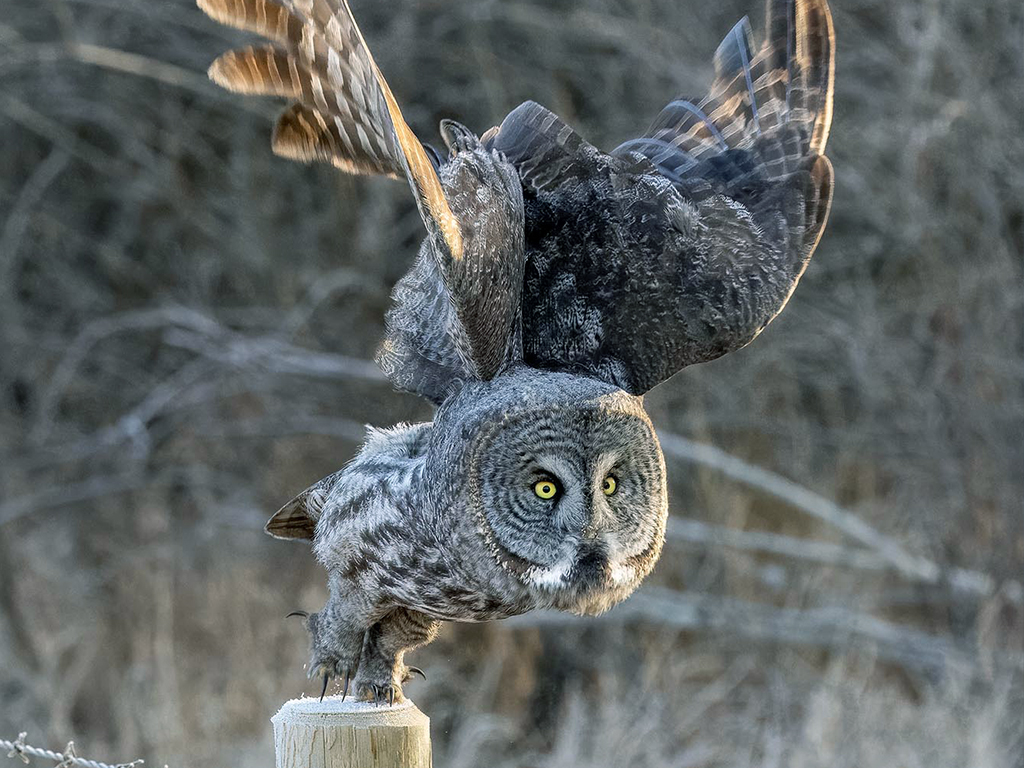
The Great Grey Owl, sometimes called the “Phantom of the North” due to its elusive nature, is one of the largest owl species in the world. These owls are found in the northern forests of North America, Europe, and Asia.
Their striking appearance includes a large round face with a prominent facial disk, and their plumage is predominantly grey with white markings. Great Grey Owls are skilled hunters, primarily preying on small mammals such as voles and lemmings.
They have a silent flight and keen hearing, which allows them to locate prey beneath snow or foliage. Despite their large size, their calls are relatively quiet hoots and soft whistles. These majestic owls symbolize the remote wilderness and are revered by bird enthusiasts.
| Kingdom | Animalia |
| Phylum | Chordata |
| Clade | Dinosauria |
| Class | Aves |
| Order | Strigiformes |
| Family | Strigidae |
| Genus | Strix |
| Species | S. nebulosa |
47. Canada Jay (Perisoreus canadensis)
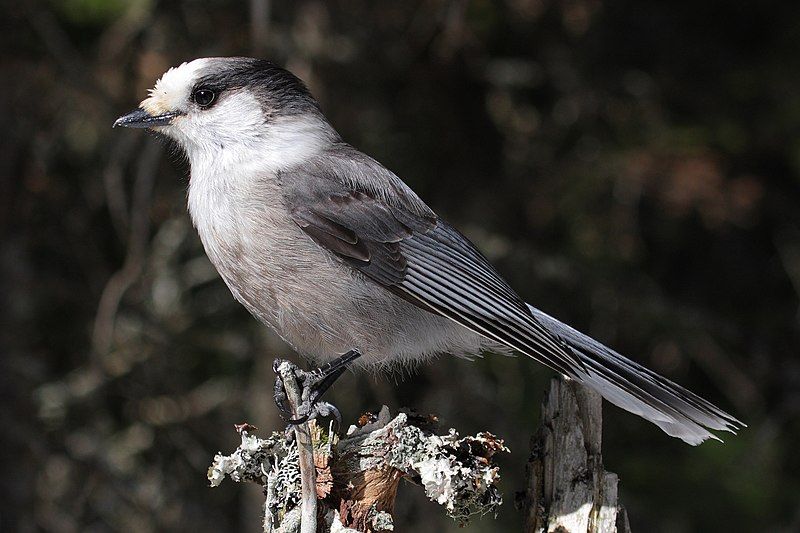
The Canada Jay, also known as the Gray Jay or Whiskey Jack, is a bird of the northern forests in North America. These jays are known for their distinctive appearance, featuring grey plumage, white undersides, and a conspicuous dark cap.
They are highly sociable birds and are often seen in small family groups. Canada Jays are opportunistic feeders, consuming various foods, including insects, berries, carrion, and even scraps from human campsites.
Their fearless and friendly nature has earned them a reputation as campsite companions. These birds are also known for their intriguing habit of caching food, storing it for later consumption during harsh winter months. Their presence adds character to the boreal forests they call home.
| Kingdom | Animalia |
| Phylum | Chordata |
| Clade | Dinosauria |
| Class | Aves |
| Order | Passeriformes |
| Family | Corvidae |
| Genus | Perisoreus |
| Species | P. canadensis |
Conclusion
As our journey through the world of “47 Winter Birds in Wisconsin” comes to a close, we reflect on these avian inhabitants’ enduring resilience and captivating beauty.
Wisconsin’s winter birds enrich our lives and ecosystems during the coldest season, from the iconic Bald Eagle soaring over frozen lakes to the charming chickadees flitting through snow-covered branches.
Through their remarkable adaptations, migratory journeys, and unwavering determination, these birds teach us the marvels of survival in the harshest conditions.
They remind us of the importance of preserving their habitats and their critical role in maintaining ecological balance.
As winter transitions into spring, may we continue to appreciate and protect the diverse and vibrant avian life that graces Wisconsin’s skies, ensuring a future where these magnificent creatures continue to thrive.